SEPTEMBER SALE
*************
THE ENTIRE MONTH OF SEPTEMER
(September 1st - September 30th)
ALL TREES &
SHRUBS 30% OFF
Fig Tree
Ginger Wine Ninebark
White Snowberry
Your Custom Text Here
Cercis canadensis Pendula, Red Bud
*************
(September 1st - September 30th)

Fig Tree

Ginger Wine Ninebark

White Snowberry
Heuchera Berry Smoothie
*************
STARTING MONDAY AUGUST 26th
Platycodon
Heuchera
Heuchera americana ‘Dales Strain’, the one we do from seed.
Monarda
*************
STARTING FRIDAY AUGUST 23rd
Lobelia, Cardinal Flower
*************
STARTING MONDAY, AUGUST 19th
Lobelia, Cardinal Flower

Inkberry

Native Great Blue Lobelia
Daylily
*************
(L to R) Coreopsis, Rudbeckia, Agastache & Allium
Some perennials are winding down but there are many other late blooming shrubs and perennials that can flourish into the fall.
*******************************
Annuals & Containers: Reinvigorate your annuals and container plants by deadheading and pruning. Add a weak solution of liquid plant food when watering your container plants.
Trees, Shrubs & Perennials: You can fertilize until the end of August especially trees and shrubs. Do not fertilize past the end of August for shrubs, trees and perennials.
Garden Maintenance: Cut back your spent perennials, you may even get a second flush of leaves and flowers. Deadhead blooming perennials to keep them fresh. Stake plants that are fallen over from bloom weight or rains.
Vegetable Gardens: Keep picking your warm weather vegetables, they will produce more and prevents them from going to seed. It’s also time to start planting your cool weather veggies, like lettuce, spinach, arugula, carrots, beets, beans, kale, and peas to be planted now for fall harvest.
Weeding: Make sure to stay on top of the weeding. Crab grass and blackberry like the warmth and can spread quietly and quickly.
ENJOY WATCHING ALL THE LATE SUMMER POLLINATORS BUSILY MOVING FROM BLOOM TO BLOOM!
Viburnum burkwoodi
*************
*************

There are over 400 species of sedums, in the family Crassulacea. They are known for their succulent foliage and drought tolerance. Sedums are easy to grow, hardy perennials that come in a range of sizes, colors and shapes and flower beautifully. Plant them in full sun and well drained soil and they will be happy campers. Some even do fine with afternoon shade.
Sedums grown at our on site production location
Creeping Sedum: Groundcover that can spread up to 3 feet. This low growing sedum usually spreads quite wide like a carpet. Many of them have little rosettes for foliage which look like flowers but are actually foliage. The Sedum major is a great example of foliage that resembles flowers.
Tall Sedum: Upright habit that can reach 2-3’ tall and wide. These taller sedums are like small shrubs. They can even work as hedges.
Trailing Sedum: Used in containers, hanging baskets or spill over rock walls.
Vineyard Gardens usually divides Sedums into the low growing, spreading type referred to as rock garden sedums and the taller more upright type many of which are in the species spectabile, which means showy.
Sedum rupestris Angelina: A rock garden spreader with yellow foliage and yellow flowers.
Sedum reflexum Blue Spruce: Great in rock gardens and have bluish gray foliage.
Sedum Steel the Show: This sedum is the perfect ground cover for a sunny garden. It has bright blue green foliage.
Sedum dasphyllum Major: A rock garden type whose foliage looks like tiny little blue flowers.
Sedum Sunsparkler Series: This series is medium size and the foliage ranges from plum purple to green with cream variegation.
We carry Dazzleberry, Plum Dazzler, Cherry Tart, Lime Zinger, Firecracker and Blue Elf.
Sedum Munstead Dark Red: A spectabile type that grows 15-18” tall with greenish foliage and dark red flowers.
Sedum Mojave Jewels Saphire: A plum colored upright sedum.
Sedum Night Light: Flower color in shades of yellow to gold. 22-26” tall; 30-36” spread.
Sedum in a planted container
Flowering yellow sedum with Butterfly Bush and Hydrangea paniculata

Echinacea purpurea illustration by karen blackerby logan
Echinacea comes from the Greek word echinos meaning hedgehog or sea-urchin in reference to the spiny central cone.
We grow several species of Echinacea, such as Echinacea purpurea, Echinacea pallida and Echinacea paradoxa. Starting plants from seed adds new DNA combinations to the species and the population. This is thought to increase chances of populations being able to adapt and fight off disease. Thus the hybrids may not be as adaptable. The native cone flowers exist in pink and yellow.
We sell countless hybrids that the horticultural industry has created from mostly Echinacea purpurea. It can take several years for a hybrid to be stable enough to be sold in the market. It is possible that some of the hybrids, which are mostly asexually propagated by cuttings or tissue culture, may not be as adaptable or hardy as the species but boy are they beautiful. The hybrids now exist in all sizes and colors including orange, red, pink, yellow or even bicolor. We carry the Sombrero series, like Salsa Red and Adobe Orange which are two of our favorites. We love many of the Echinacea hybrids like Green twister and White Swan.
*If food for pollinators is your #1 reason for planting Echinacea, either plant the native species or pick the single hybrids. The doubles are not believed to be good food for pollinators. Many of the doubles are sterile and produce no seed.
****************

***************
SOMBRERO SERIES
(Continues to be one
of our favorites!)
Salsa Red
Adobe Orange
Hot Coral
Lemon Yellow
Rosada
Summer Solstice
Tres Amigos
Sangrita
***************


***************
SUNSEEKER SERIES
(Tall with beautiful flowers that
often transition to other colors as
they mature. Some can be
double.)
Rainbow
Salmon
Perfection
***************

***************
Green Wizard
(The flower petals are
yellow-green
on the tips and
bleed into a pale
pink closer to
the cone.)
***************
Old Fashioned Hybrid
Ruby Giant
(Quite tall with
large pink flowers)
***************


***************
Ruby Giant
Green Twister
(Very hardy)
***************
New this year!
We are testing for hardiness.
Dark Shadows Wicked
Orange You Awesome
The Fuschia is Bright
One in a Melon
Summer Song
Fire Finch
Baja Burgundy
***************
Attracts all types of butterflies, birds, bees and other pollinators!
Let the later blooms stand throughout winter, where the characteristic central cone swollen and full of seed offers an excellent food source for birds. Once spring arrives, simply cut back your coneflowers to the ground.
Medicinal use: to help boost the immune system and shorten the duration of the common cold and flu. Echinacea flowers are often associated with health and healing.
Herbaceous perennial that is native to the mid west prairies of the US.
An adaptable plant that is tolerant of drought, heat, humidity and poor soil.
Easily grown in average, dry to medium, well-drained soil in full sun.
Coneflowers are not fussy. They aren’t particularly bothered by pests and do not require fertilizer.
Mid-summer bloom

Echinacea Sombrero Salsa & Sangrita
Native summer blooming shrubs offer immeasurable benefits. Shrubs are considered the bones of the landscape, creating habitat for birds and small mammals in all four seasons. Shrubs offer protection, nectar and pollen for a wide range of fauna, bees, butterflies, insects and nesting and feeding songbirds. Growing season is lengthened from the early bloomers through the fall berries. In Nature’s Best Hope and Bringing Nature Home, Doug Tallamy describes keystone plants as “native plants that are essential to our ecosystems because they support 90% of the caterpillar species that enable our terrestrial birds to reproduce, as well as all of our specialist native bee species.”
Buttonbush, Cephalanthus occidentalis
****************************************
BUTTONBUSH
If you live along a wetland, have a soggy area in your yard or are considering a rain garden then buttonbush is the shrub for you. It is an excellent wetland shrub that requires consistent moisture, can tolerate clay soil and standing water.. They flower abundantly in the summer with fuzzy ball shaped flower clusters backed by glossy leaves. Their aromatic flowers attract bees, hummingbirds and butterflies, such as tiger swallowtails. Nearly two dozen butterfly and moth larva are drawn to buttonbush. Bright red seed heads that follow in the fall provide food for songbirds, small mammals and waterfowl.
USES: Rain gardens, retention ponds, erosion control
************************************
SMOOTH HYDRANGEA
Hydrangea arborescens, our native hydrangea, is found along rocky wooded slopes, ravines, streambanks, and bluff bases in the eastern United States. Smooth hydrangea is the host plant of the hydrangea sphinx moth and attracts butterflies, moths, pollinators and songbirds. The blooms are on new wood and can be pruned back close to the ground in late winter. Several cultivars have flowers that make a ball-shaped bloom. This low growing hydrangea fits nicely beneath taller trees and shrubs.
USES: Mass planting, native specimen, pollinator garden, rain garden, shade garden, grows well on a slope, naturalized area or in a woodland
************************************
SWEET PEPPERBUSH
Clethra is a wonderful addition to any garden, a versatile shrub that can thrive in most conditions. Typically found in open woodlands or swamps along the Atlantic coast this workhorse can flower from full sun to shade. Clethra prefers moist soil but can even adjust to dry, compact soil. It is a sweet scented native shrub that is a pollinator magnet. The white spire blooms lure butterflies, bees and hummingbirds. In addition, to being a hardy shrub, Clethera has year round interest. The deep green summer leaves turn yellow in autumn and in winter clusters of attractive seed pods remain.
USES: Seaside plantings, mass plantings, hedges or rain gardens
Hydrangea paniculata[illustration by karen blackerby logan]
****************************************

Panicle Hydrangeas are the no fuss hydrangea with long lasting blooms. They range in size from large to compact depending on variety, allowing for many planting options in the landscape. A late blooming shrub, they become the autumn stars when most other shrubs are no longer blooming. Triggered by air temperature fluctuations and day length Hydrangea paniculata go through a color transformation starting with an early summer white that fades to shades of pink or red before drying to beige in the winter. Their nectar-rich flowers attract butterflies and bees late into the season, providing them with a vital food source.
******************************************
Panicle Hydrangeas thrive in full sun or morning sun, a place in the garden that mophead hydrangeas don’t flourish.
They bloom on new growth each summer so prune early in spring. There is also no risk of flower buds being harmed by the cold winter or late frost because they bloom on this years growth.
As the rest of the garden winds down, the fall panicle hydrangeas take center stage.
Flowers can even be left to dry on the plant in the fall and can stay looking good into the winter.

Quick Fire Hydrangea

hydrangea paniculata
**********
Limelight
Limelight Prime
Little Lime
Quick Fire
Little Quick Fire
Bobo (dwarf variety)
Grandiflora
Phantom
Fire Light

Hydrangea paniulata Bobo

USES
____________
* Variety of sizes means
there’s a perfect fit for
most situations
* Smaller specimens
ideal for foundation,
mass or container
planting
* Larger specimens ideal
for hedges and
back of the garden
Andew Wiley, working on Vineyard Gardens display bed
Vineyard Garden’s Andrew Wiley, a creative plant ‘genus’
*******************************
It’s not just a job for Andrew Wiley, his passion for plants is infused in his bloodline. As a child he grew up at Vineyard Gardens, watching his horticulturalist parents, Chris and Chuck Wiley develop a singular greenhouse and lawn mowing business into the vibrant establishment it is today. Not only did Andrew soak in the atmosphere and information as a boy, he now embraces everything about plants, landscaping and design. After an unmatched year at Great Dixter House & Gardens, Andrew’s plant knowledge and creativity in the landscaping world has been unleashed. His ethereal and poetic gardens are a wonderful demonstration in succession planting, filling garden beds with continuous blooms throughout the year. His front bed display at Vineyard Gardens is constantly evolving, never a dull moment from one plant finishing it’s bloom cycle to a new one opening up. Within the display bed there are many beautiful vignettes that seamless work together as a whole.
“This photo is reminiscent of my time in England at Great Dixter All three of these plants can be found in the garden there. This Phlox was originally a seedling given to Christopher Lloyd by Margery Fish and is known at Dixter as Phlox paniculata ‘Margery Fish.’ Piet Oudolf decided to name the phlox ‘Dixter’ as it was never given a trademark name, something Great Dixter does not do with their plants for various reasons. The Salvia is one of my favorite biennials, best practice is to always plant all biennials in the fall. This will always give you bigger and better plants with much longer bloom time than if planted in Spring. The Marigold (Tagetes) was used on the Long Border at Dixter where Fergus received the seeds from a conference in France. I collected and brought back seeds from these plants. A true scrambler this Marigold gets huge and is best planted where it can tumble over and sprawl around.” Andrew Wiley
*********************
Have you ever had the chance to walk through a garden with Andrew? His energy and excitement for designing with plants is unmeasured. Spewing off latin names and talking about the evolution of gardens and biodiversity you feel like you just had a master class in horticulture. Andrew’s contagious spirit will have you walking away from Vineyard Gardens with a million plants because he made you fall in love with every single one of them!
*********************************

Camellia illustration by Karen Blackerby Logan
************************
Broadleaf Evergreens are known to tolerate shade and many will also grow well in full sun. With their year round foliage they can add interest to your beds, woodland borders or create screening in a shady spot between you and your neighbor. Broadleaf evergreens can give you the privacy you need. They can also create fabulous backdrops to deciduous plants that flower. Plant them young and they will grow larger every year. We also carry several species of smaller broadleaf evergreen shrubs that can take shade. These work well in foundation plantings or in your shrub or perennial beds.

Pieris japonica illustration by karen blackerby logan
***************************
Prunus schipkaensis (Skip Laurel)
Azaleas
Leucothoe
Osmanthus heterophyllus (False Holly) : Seldom severely damaged by deer. Looks like holly. We have found the species heterophyllus to be hardy, able to survive in dense shade and they are deer resistant. The flowers are fragrant! We carry a popular variegated variety called Goshiki.
Pieris japonica (Andromedas): Blooms in spring with panicles of beautiful bells mostly in white. We do carry a pink blooming one. Can grow 6-8ft tall and 5-6ft wide. We carry dwarf ones as well. Deer resistant.
Skimmia japonica: Needs a male and a female to be planted together for the female to berry up.
Skimmia reevesiana: Rarely damaged by deer. Does not need a male to cross pollinate like Skimmia japonica.
Prunus schipkaensis (Skip Laurels): They will easily get 6-8ft tall. Good for flowers and for screening.
Photinia fraserii: At the margins of its hardiness zone. It has handsome evergreen foliage. The new growth is reddish and in cold weather the leaves turn reddish again. It can grow over 6ft tall and wide.
Leucothoe, Skimmia and some Pieris japonica are examples of smaller broadleaf evergreen shrubs that can take shade.
***************************
Camellia japonica
Camellias and Aucubas should be planted near foundation plantings or by a stone wall for the heat they absorb during a sunny day. They may get some die back during a very cold winter. Prune the dead ones out in the spring. Camellias have shiny lovely evergreen foliage and flowers that look like Peonies. Aucubas need a male to berry up. Aucuba Mr. Goldstrike will pollinate Aucuba serratifolia, which is known for producing large red, berry like fruit.
Aucuba japonica
serratifolia
Mr. Goldstrike
Camellia April Pink
***************************
Buxus Green Gem
(Rarely damaged by deer)
Buxus Winter Green
Buxus Green Beauty
Buxus Variegata
***************************
Rhododendron Catawba
Roseum Elegans & Catawba Rhododendron get over 10ft tall. Plant them young and they will grow larger each year. Great for flowers and for screening.
Catawba Rhododendron (Native)
Maximum Rhododendron (Native)
PGM Rhododendron
***************************
Mahonia Winter Sun
(All Native) (Rarely damaged by deer)
Mahonias are also known as Oregon Grape Holly. They bear panicles of purple fruit after flowering that look like grapes.
Mahonia repens
Mahonia Winter Sun
Mahonia Charity
Mahonia Arthur Menzies
Mahonia nervosa
***************************
Ilex crenata Steeds
Hollies are always a good choice for shade. We carry American, English, Japanese Chinese and hybrid Hollies. Several of the Japanese Hollies (Ilex crenata) are smaller shrubs. Blue Hollies (Meserve Hybrids) are like shrub Hollies instead of tree Hollies and can be pruned and kept a bit shorter. The Hollies need a male to pollinate the female to get the berries. We also grow specialty Hollies from cuttings. Ask at the nursery about our collection.
Meserve Hybrids (Blue Hollies)
Ilex Dragon Slayer
Ilex mes Blue Maid
Ilex Robin
Ilex x Greenleaf
Ilex crenata
Ilex Steeds (Ocassionally severely damaged by deer)
Hoogendorn
Soft Touch
Sky Pencil
***************************
for trees and shrubs
for landscacping
Rose of Sharon illustration by karen blackerby logan
Hibiscus plants add a bold, tropical effect to the garden with their huge, dinner-plate colorful flowers.
There are over 100 species of Hibiscus in the family Malvacea. They are mostly found in tropical areas but a few are hardier and will overwinter in our climate. Due to their tropical nature they are later to emerge and most bloom in mid to late summer. We grow both annual, perennial and shrubs in the hibiscus family. We carry other popular ornamental perennial plants in the Malva family that have similar flowers to Hibiscus, such as Hollyhocks (Alcea)and Sidalcea.
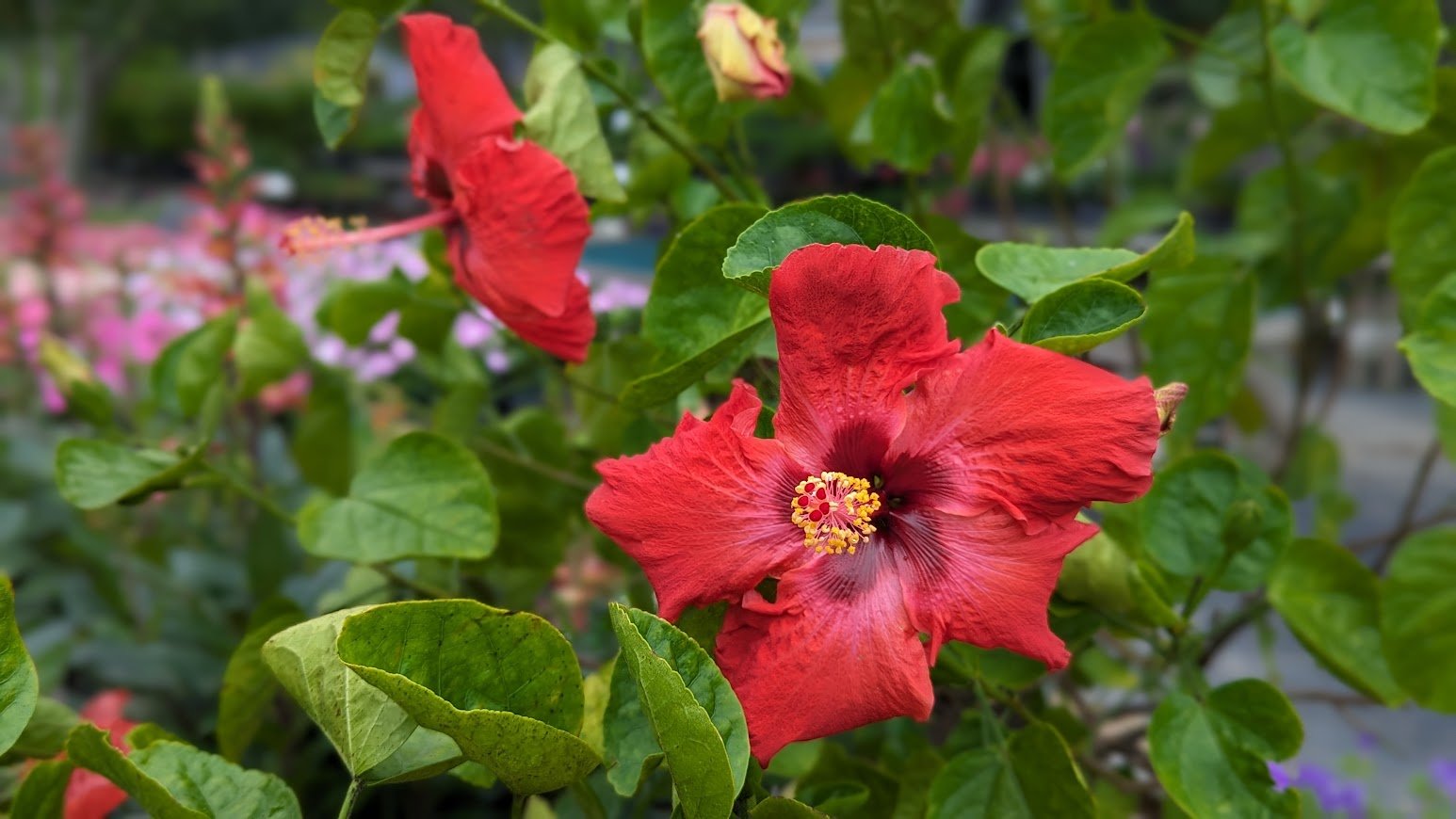
Jazzy Jewel Ruby Hibiscus (Tropical Hibiscus)
*************************************
Hardy Hibiscus primarily includes the species native to North America such as Hibiscus moscheutos. These plants are true perennials, tend to have the largest flowers and die back to the ground each year. The species Hibiscus is known as Rose Mallow or Swamp Mallow and is native to Martha’s Vineyard. They are highly valued for their beautiful flowers late in the season. The pink flowers grow around ponds on the south shore and bloom profusely in mid to late summer. At Vineyard Gardens, we sell the species, as well as many hybrids with a wide range of flower colors (pink, purple, white, red & bi-color), large flower sizes and green to deep dark foliage. These perennials die to the ground in winter and emerge from the crown of the plant the following season.
____________________
CARE OF HARDY HIBISCUS
Hardy hibiscus needs frequent watering, especially when young and new. When watering, do so deeply and thoroughly, drenching the plant.
Mulch around the plant to retain moisture and to provide winter protection for the roots.
To encourage rebloom, either remove the spent flowers before they form seed heads or prune plants back by one-third after a flush of bloom is finished.
Perennial hibiscus will freeze back to the ground each winter; cut old stems to the ground.
Hibiscus bloom on new wood (this year’s growth), so pruning is best done in the spring.
In early spring, remove dead stems from established plants and apply a balanced fertilizer.
Mature plants can be divided in the spring, not fall.
Plant them in full Sun.

Varieties available
______________
Hibiscus mosheutus
Kopper King
Perfect Storm
Berry Awesome
Holy Grail
Candy Crush
![Hibiscus 'Berry Awesome' [photo credit Walters Gardens, Inc]](https://images.squarespace-cdn.com/content/v1/581a4aee8419c21ac8e2a58f/1721184861844-DEORC3R0F76KLRQFY25J/Hibiscus+%27Berry+Awesome%27+PP27936+CPBR5647+0001+high+res_waltersgarden.jpg)
![Hibiscus 'Berry Awesome' [photo credit Walters Gardens, Inc]](https://images.squarespace-cdn.com/content/v1/581a4aee8419c21ac8e2a58f/1721184873731-T9TMW5MLVHJR7IHM3RZO/Hibiscus+%27Berry+Awesome%27+PP27936+CPBR5647+0002+high+res_waltersgarden.jpg)
![Hibiscus 'Candy Crush' [photo credit Walters Gardens, Inc]](https://images.squarespace-cdn.com/content/v1/581a4aee8419c21ac8e2a58f/1721184873328-XDJQOX1NMIOCNLIL52Q6/Hibiscus+%27Candy+Crush%27+PP32587+CPBRAF+0000+high+res-waltersgarden.jpg)
![Hibiscus 'Dark Mystery' [photo credit Walters Gardens, Inc]](https://images.squarespace-cdn.com/content/v1/581a4aee8419c21ac8e2a58f/1721184875920-V9A6T09VI7TWQOHKPYNS/Hibiscus+%27Dark+Mystery%27+PP32036+0001+high+res.jpg)
![Hibiscus 'Holy Grail' [photo credit Walters Gardens, Inc]](https://images.squarespace-cdn.com/content/v1/581a4aee8419c21ac8e2a58f/1721184884774-AMGUI6E09XHJNL95I3OC/Hibiscus+%27Holy+Grail%27+PP31478+CPBRAF+0005+high+res.jpg)
![Hibiscus 'Marshmallow Moon' [photo credit Walters Gardens, Inc]](https://images.squarespace-cdn.com/content/v1/581a4aee8419c21ac8e2a58f/1721184881911-H4SMV7QWEE6DZATXPBBK/Hibiscus+%27Marshmallow+Moon%27+PP35990+0001+high+res.jpg)
![Hibiscus 'Midnight Marvel' [photo credit Walters Gardens, Inc]](https://images.squarespace-cdn.com/content/v1/581a4aee8419c21ac8e2a58f/1721184884818-SL37C4I1W1F8OW2KI013/Hibiscus+%27Midnight+Marvel%27+PP24079+0001+high+res.jpg)
![Hibiscus 'Perfect Storm' [photo credit Walters Gardens, Inc]](https://images.squarespace-cdn.com/content/v1/581a4aee8419c21ac8e2a58f/1721184888055-55KI3BZMLO5FXZKYFJBX/Hibiscus+%27Perfect+Storm%27+PP27880+CPBR5648+0003+high+res.jpg)
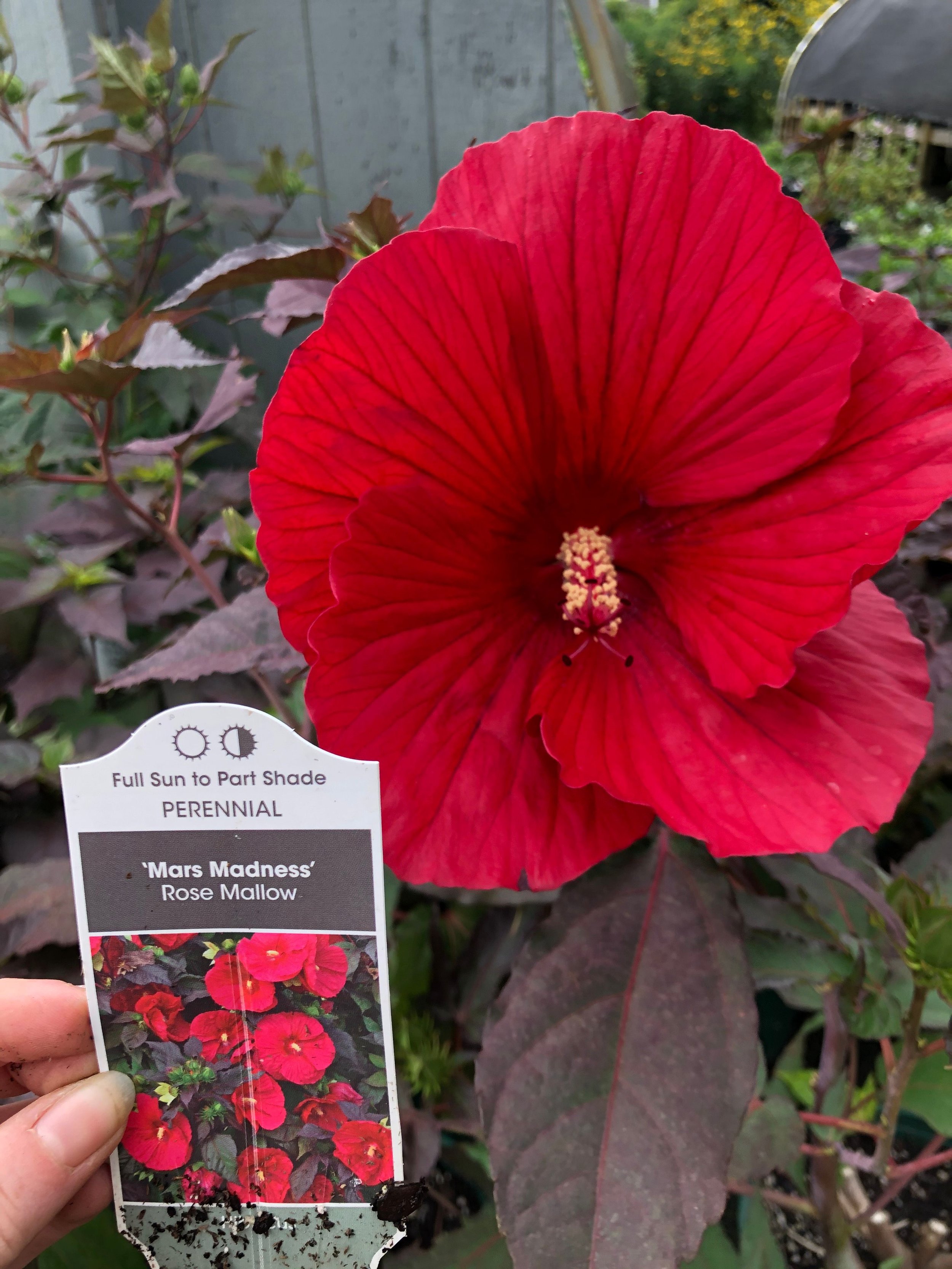
[1. Hibiscus ‘Berry Awesome 2. Hibiscus ‘Berry Awesome 3. Hibiscus ‘Candy Crush’ 4. Hibiscus ‘Dark Mystery’ 5. Hibiscus ‘ Holy Grail’ 6. Hibiscus Marshmallow Moon’ 7. Hibiscus ‘Midnight Marvel’ 8. Hibiscus ‘Perfect Storm’ 9. Rose Mallow ‘Mars Madness’ . All photos above credit to Walters Gardens, Inc]

Midnight Marvel
Dark Mystery
Marshmallow Moon
(LUNA SERIES)
Luna Red
Luna White
(DISCO BELL SERIES)
Pink
*************************************
The most popular shrub is the Rose of Sharon also known as Hibiscus Syriacus. Rose of Sharon has a woody habit and bloom on the same structure each year. It has beautiful hibiscus like flowers in mid to late summer and is valued as an ornamental in landscapes. These tend to be the largest in size with some varieties getting 15′ tall.
____________________
CARE OF ROSE OF SHARON
Full Sun woody shrub
A little late to emerge in spring because of its tropical roots
Blooms on new growth, therefore best pruned in spring when buds start to swell and plant comes to life
Prune out a few of the biggest oldest stems as low as possible. Encourage young stems as these will produce the most flowers, and growth from down low in the shrub. That helps keep it looking full. Rose of Sharon grow from the tips so they can lack growth down low if not pruned properly.
Fertilize new plantings with a slow release complete fertilize
Rose of Sharon

Varieties available
____________
HIBISCUS SYRIACA
(ROSE OF SHARON)
(Single Flowers)
Diana
Aphrodite
Fiji
Red Heart
Minerva
Blue Satin
(Double Flowers)
Chiffon Blue
Chiffon Lavender
Chiffon Pink
Hibiscus syriacus
*************************************
The annual hibiscus we carry is the tropical hibiscus also known as Hibiscus rosa sinensis. Hibiscus rosa-sinensis, are from southeast Asia and are technically a shrub but less hardy than Rose of Sharon. This plant makes a lovely garden or container plant and will bloom all summer long. We usually carry it in both shrub form and as a topiary patio tree. The tropical hibiscus is not frost tolerant.

Hibiscus Tropical Jewel Ruby

Varieties available
______________
HIBISCUS TROPICAL
The Path
Cherie
Hula Girl
Red Dragon
***
Jazzy Jewel Series
Opal
Ruby
Amber
Gold

Hibiscus Too Hot To Handle
Hibiscus illustration karen blackerby logan
____________________
Prefer full sun. They will grow in partial sun but will not flower as well.
Prefer well-draining soil with plenty of organic matter, and neutral to slightly acidic soil.
To avoid breakage of the long stems, plant hibiscus where they won’t be exposed to strong winds.
____________________
Hibiscus Brilliant (Tropical Hibiscus)

Hibiscus Hula Girl (Hibiscus Tropical)
*************************************
Gorgeous combination of Thalictrum ‘Elin,’ Aquilegia, Euphorbia and the leaf and seed pod of Paeonia delavayi. The glowing spikes on the right are from a bedding pocket of a pale yellow Digitalis [photo by Andrew Wiley]
******************************************
Even if your yard is shady, you can still have beautiful flowers and foliage! If your yard needs more sun but you don’t want to cut down trees you can limb up or thin out a few trees to let in more sun. On the other hand, If you have a very sunny garden and want to grow some of these wonderful shade perennials, plant a few small trees or large shrubs in the beds. Not only will they provide a little shade but height and size will add interest to perennial beds.

Alchemilla
Anemone
Asarum
Astilbe
Cimicifuga
Clematis
Dicentra
Epimedium
Euphorbia
Ferns
Foxglove
Galium
Ferns, Heuchera & Columbines

Geraniums (perennial)
Hackonechloa
Heucheras
Hostas
Ligularia
Pachyhsandra
Polygonatum
Rodgersia
Sanguisorba
Thalictrum
Vinca
**************************************
Perennials that thrive in shade often do quite well with more sun, as long as they get enough water. The reverse does not apply. Perennials that need sun often grow long and leggy in the shade. Plants that evolved in shade, usually in the understory of other plants, often have larger leaves to capture as much sun as possible. Some good examples are Rodgersias, Hostas, Astilboides and many Heucheras, like the popular Autumn Bride. These plants usually like a rich moist but well drained soil.
**************************************


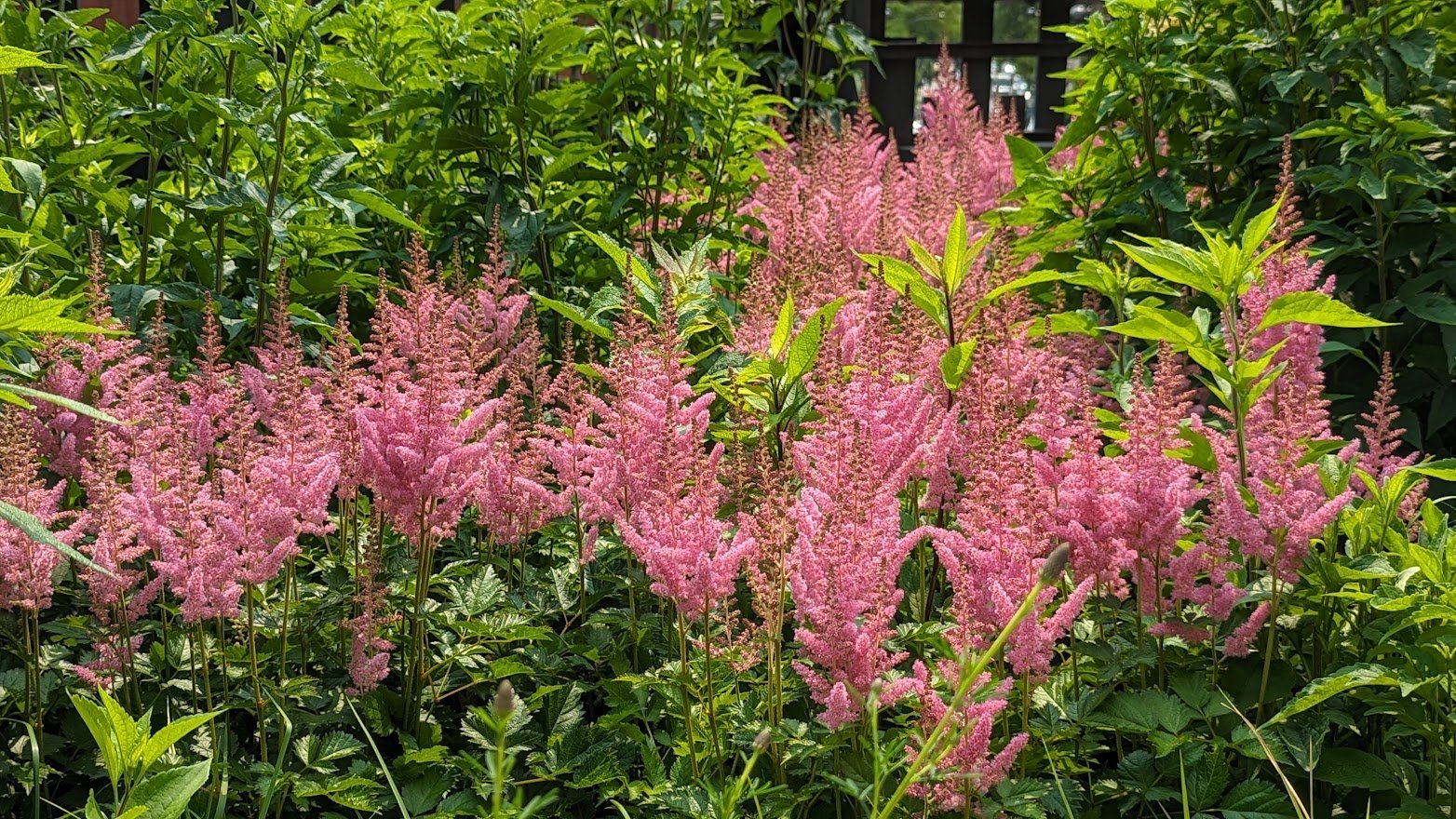
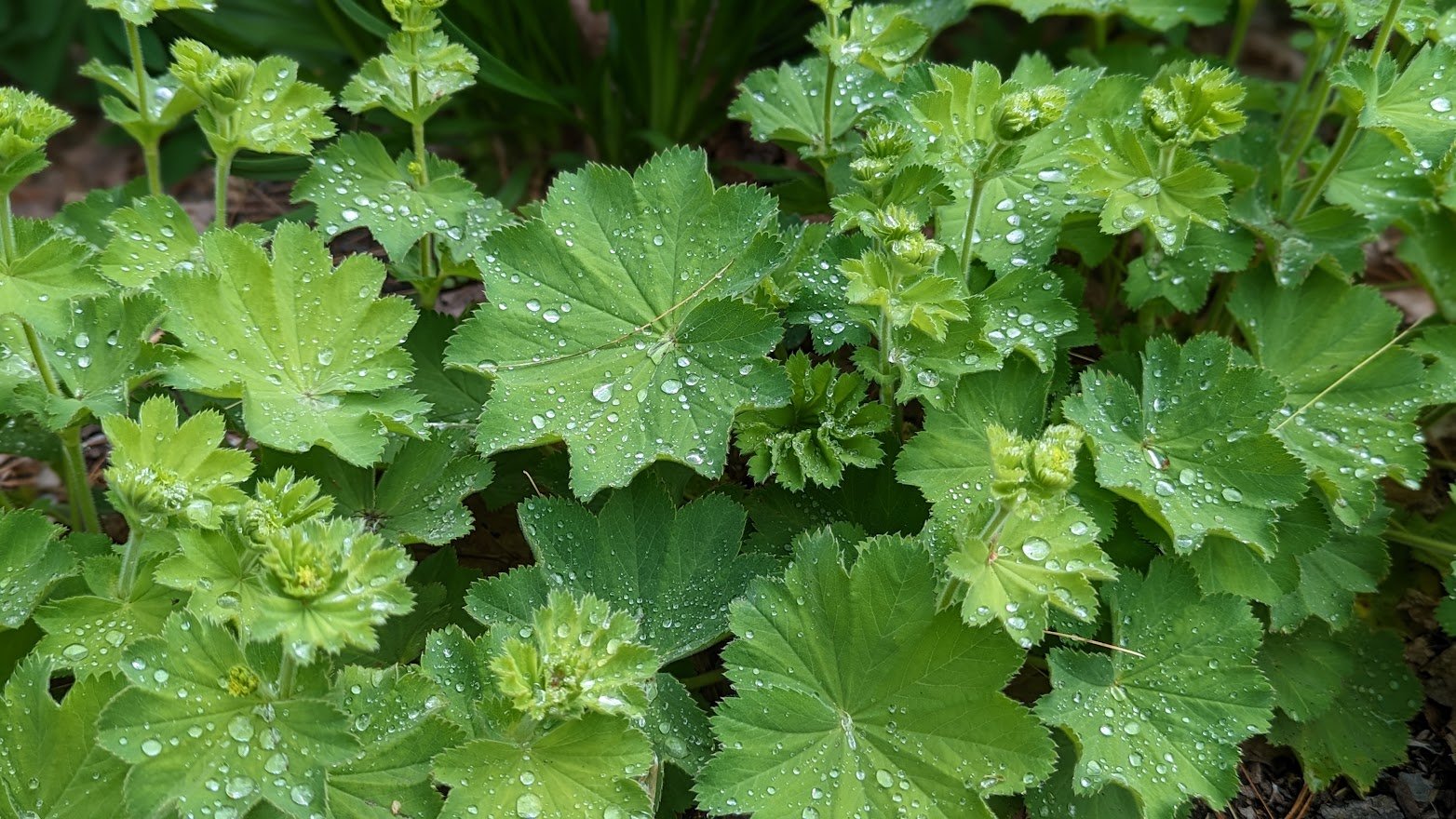
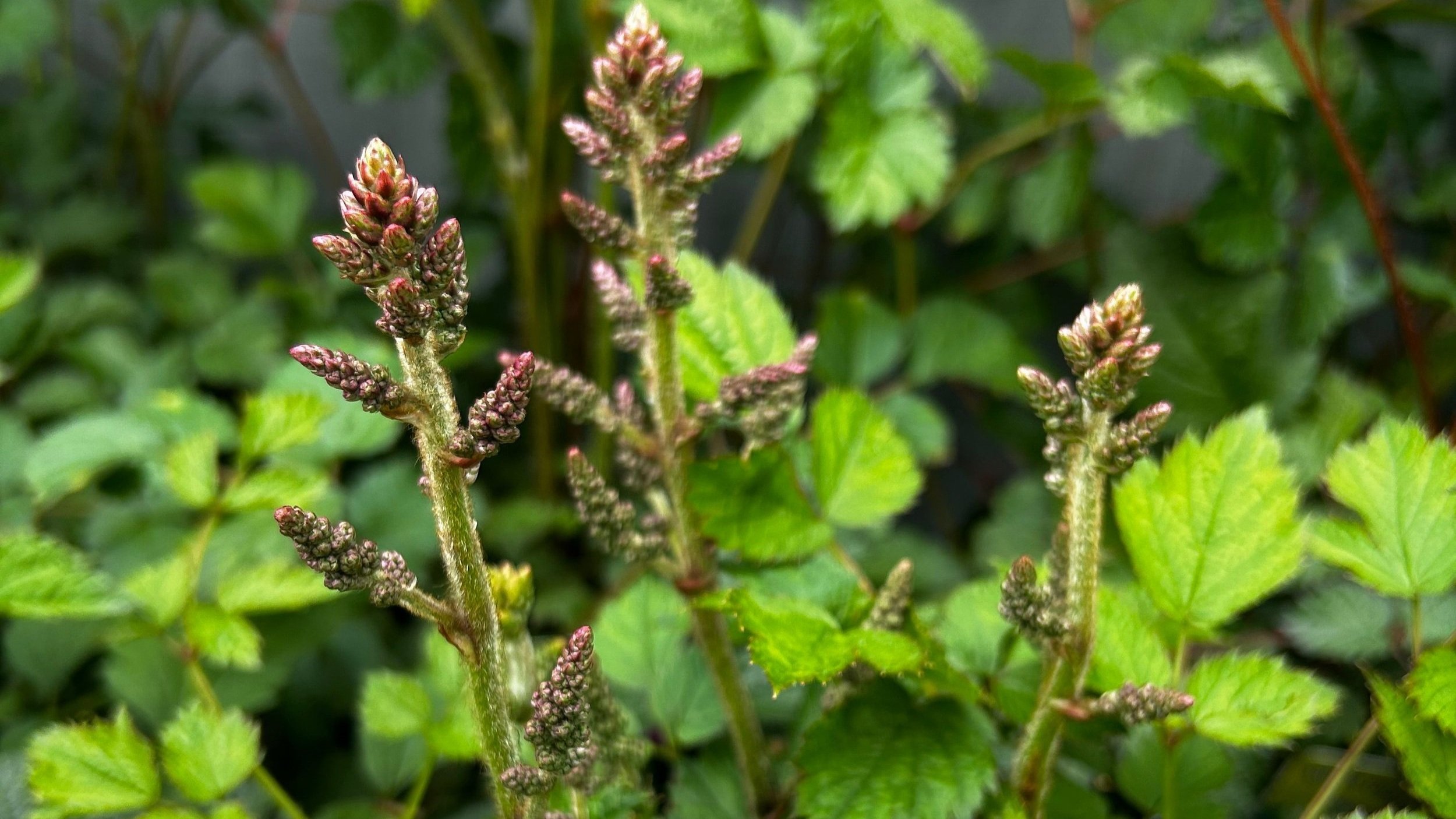


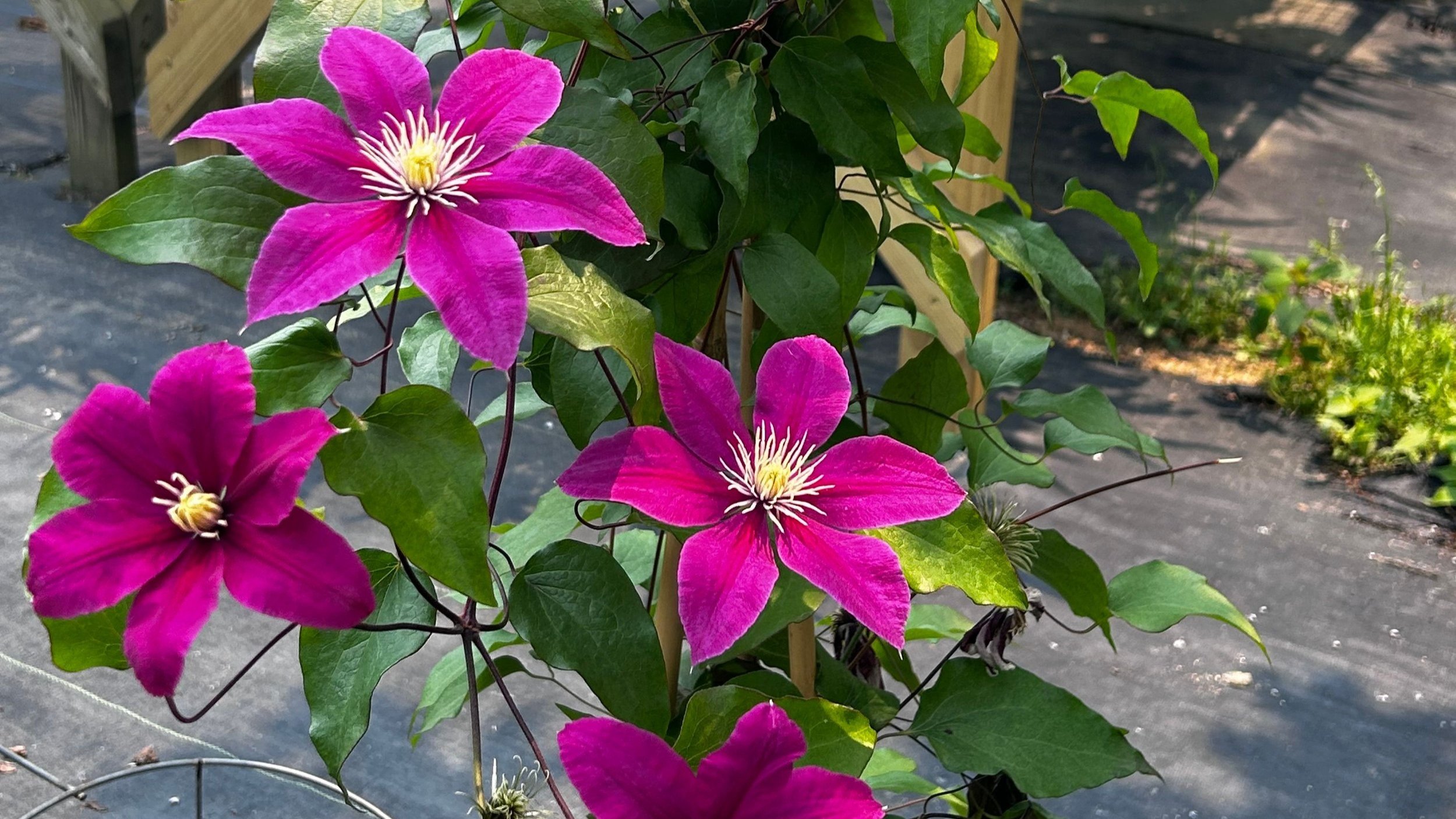
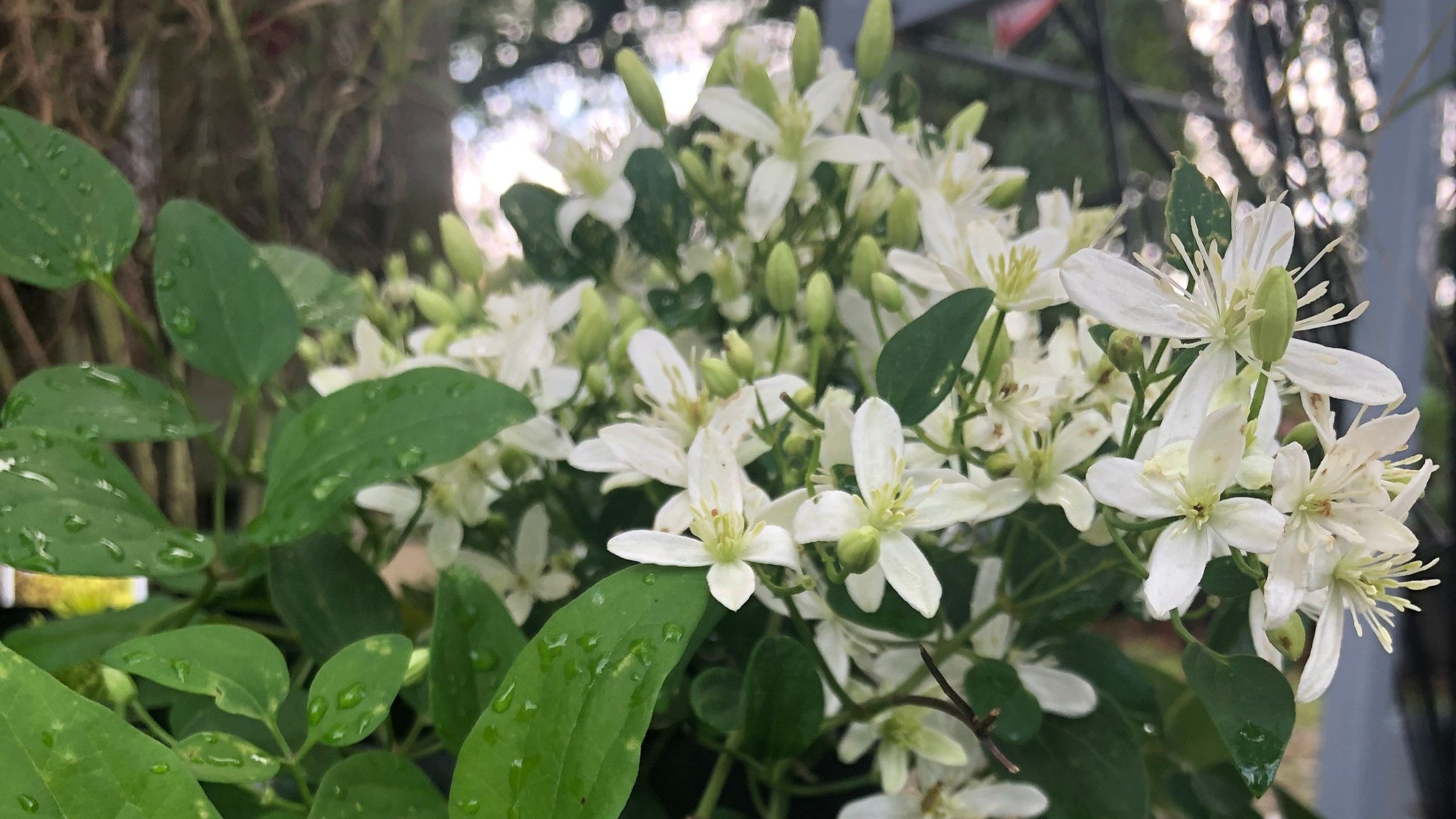
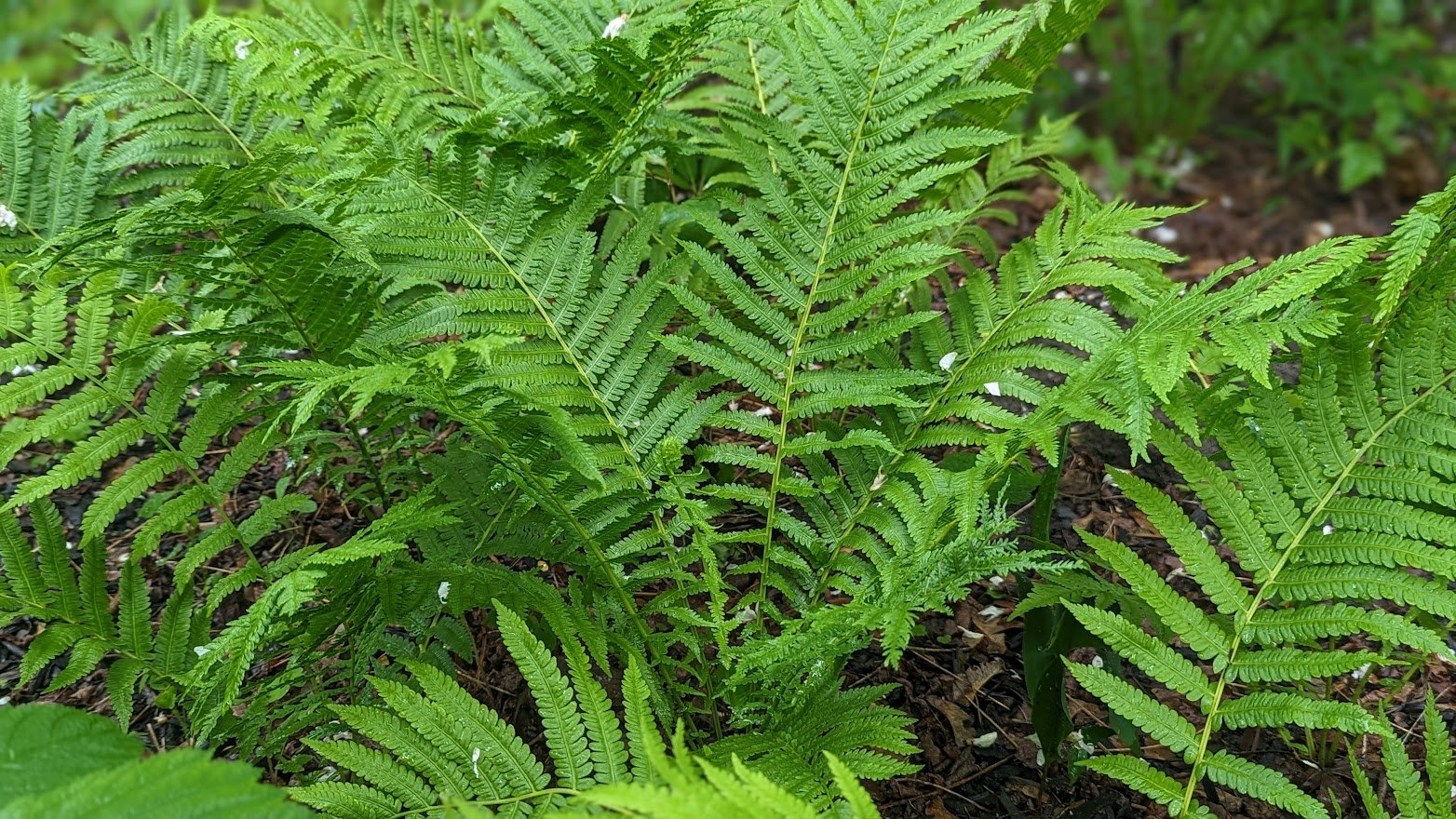
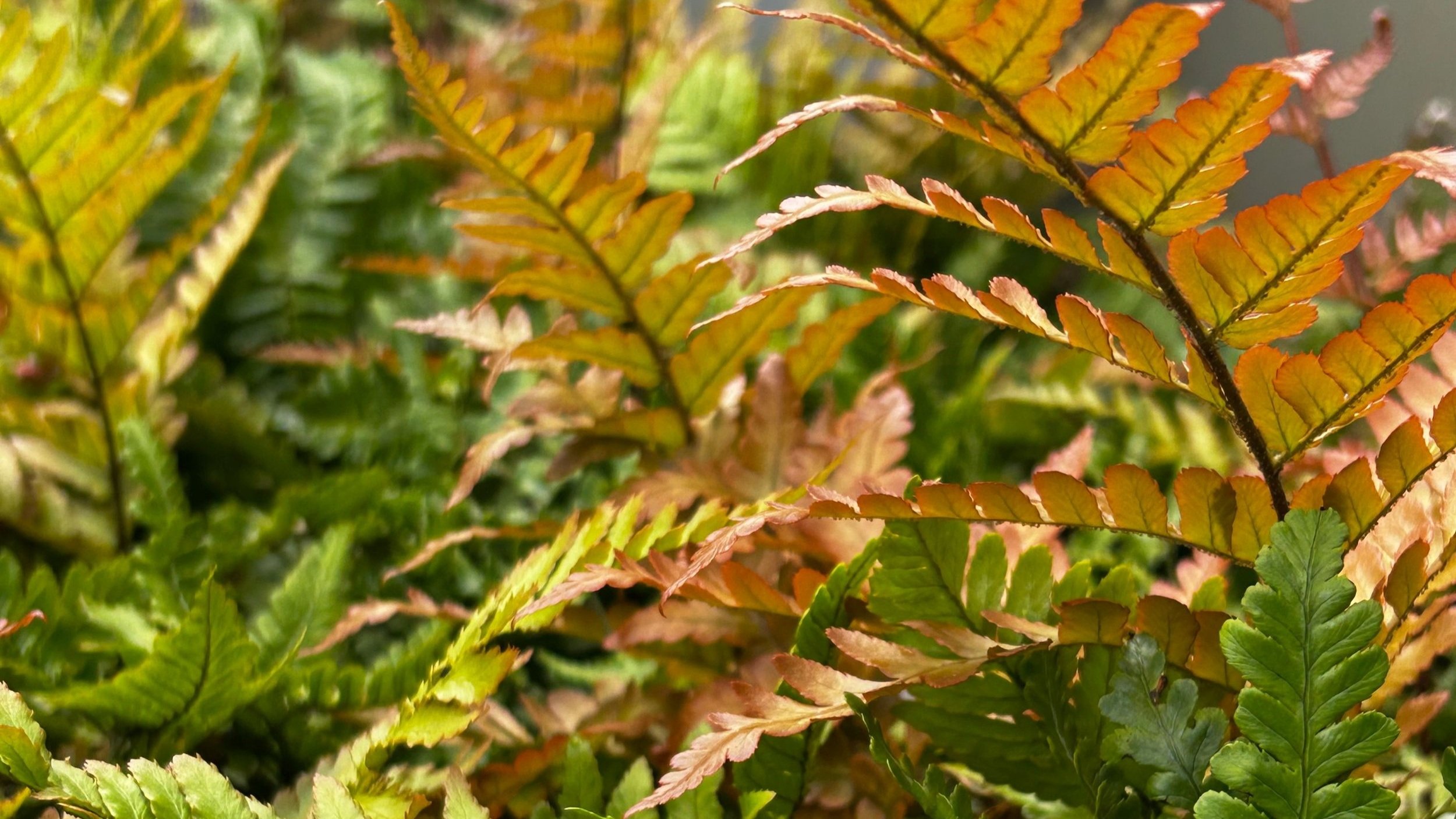
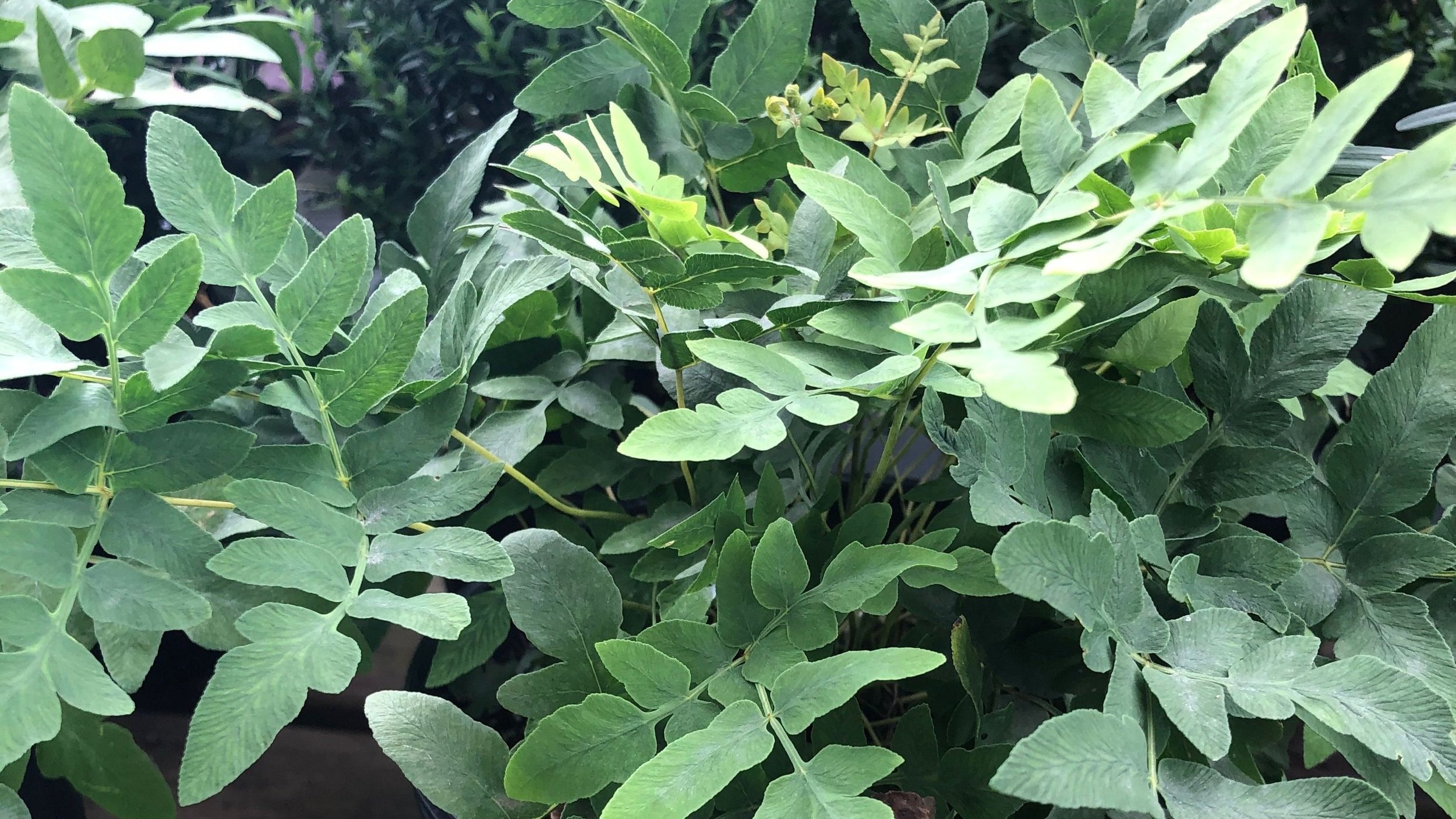
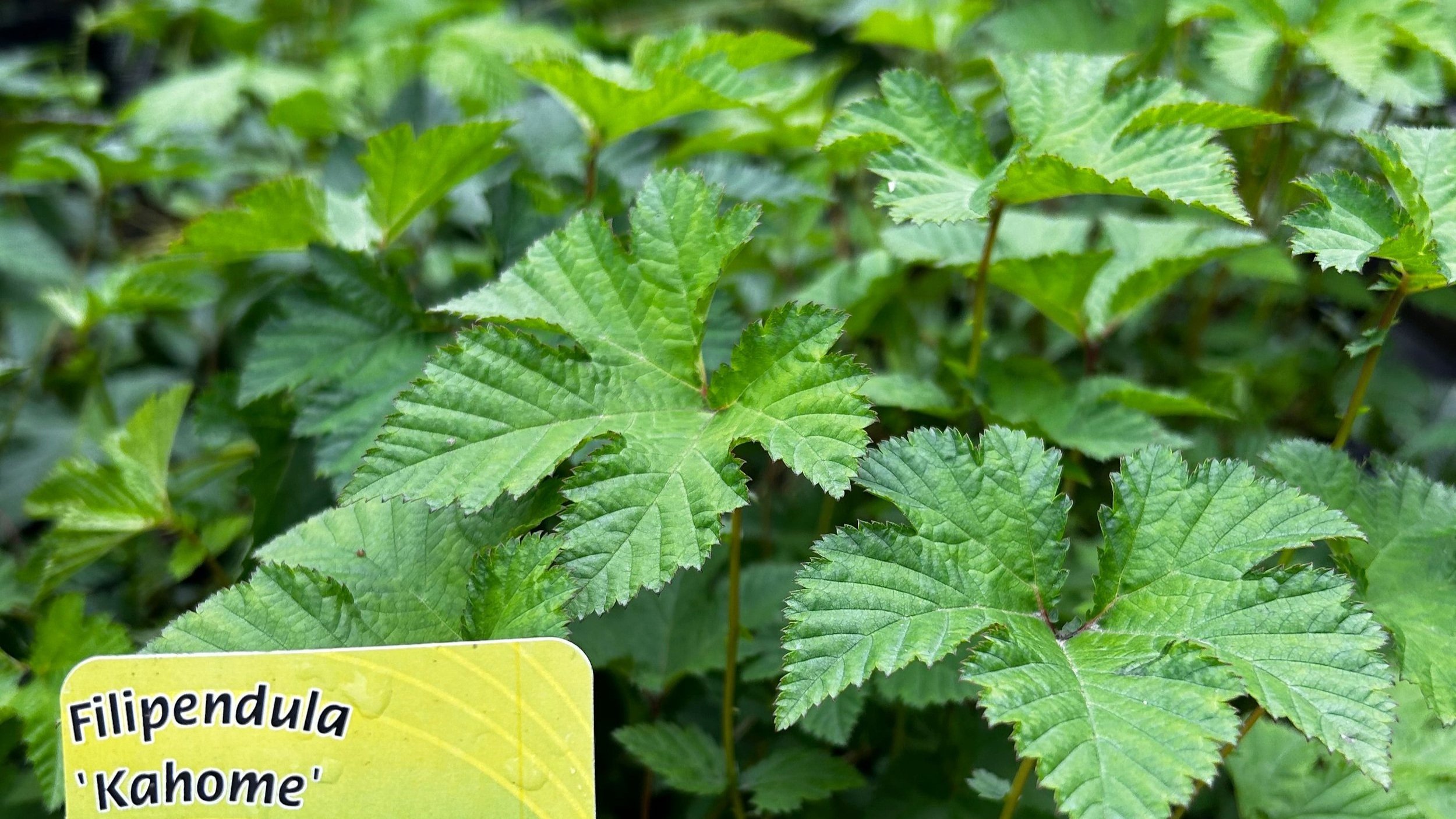
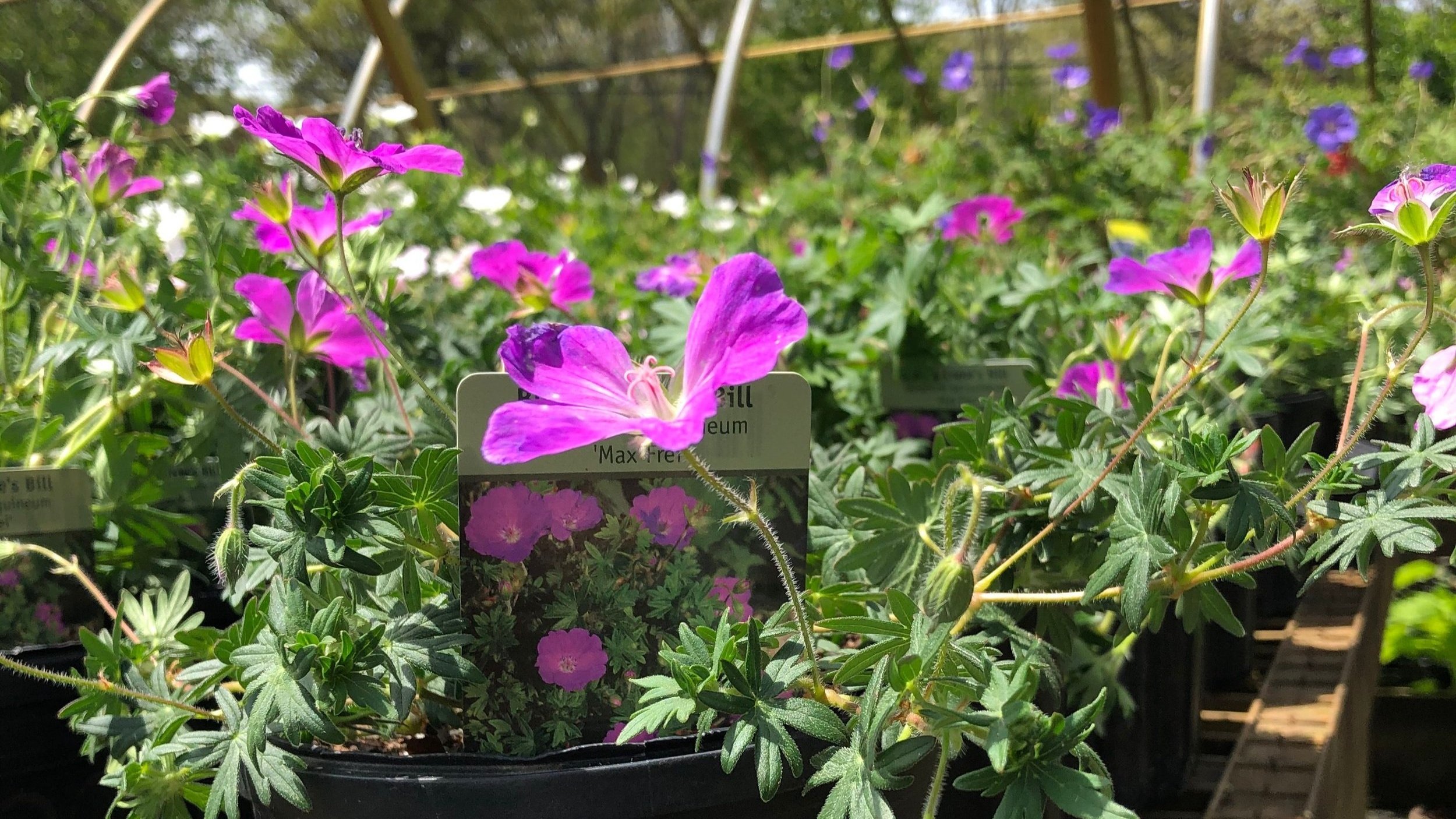

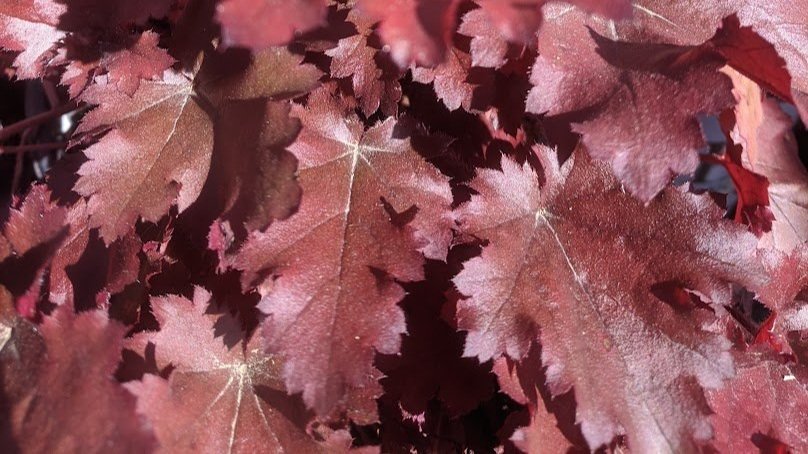

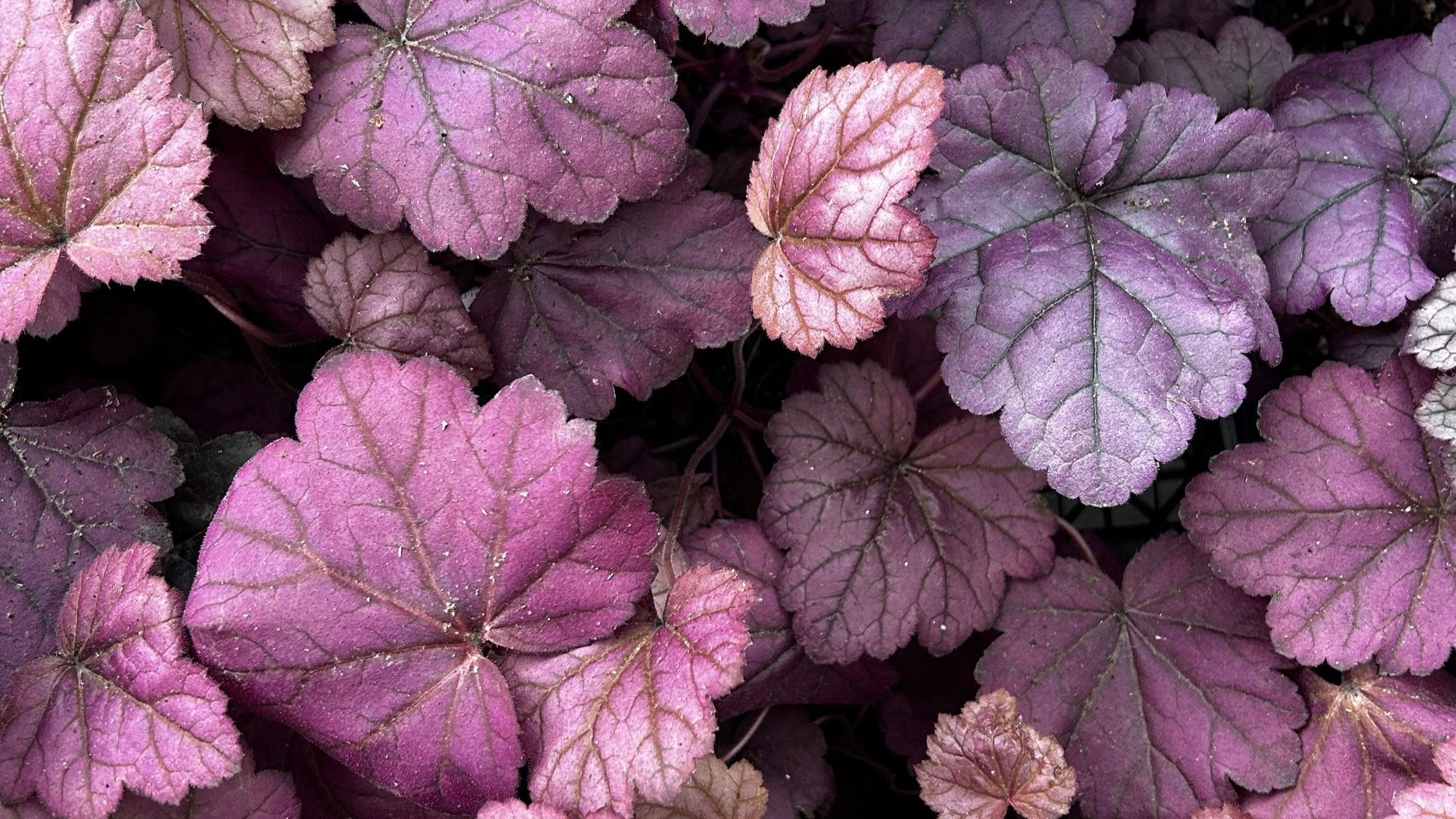
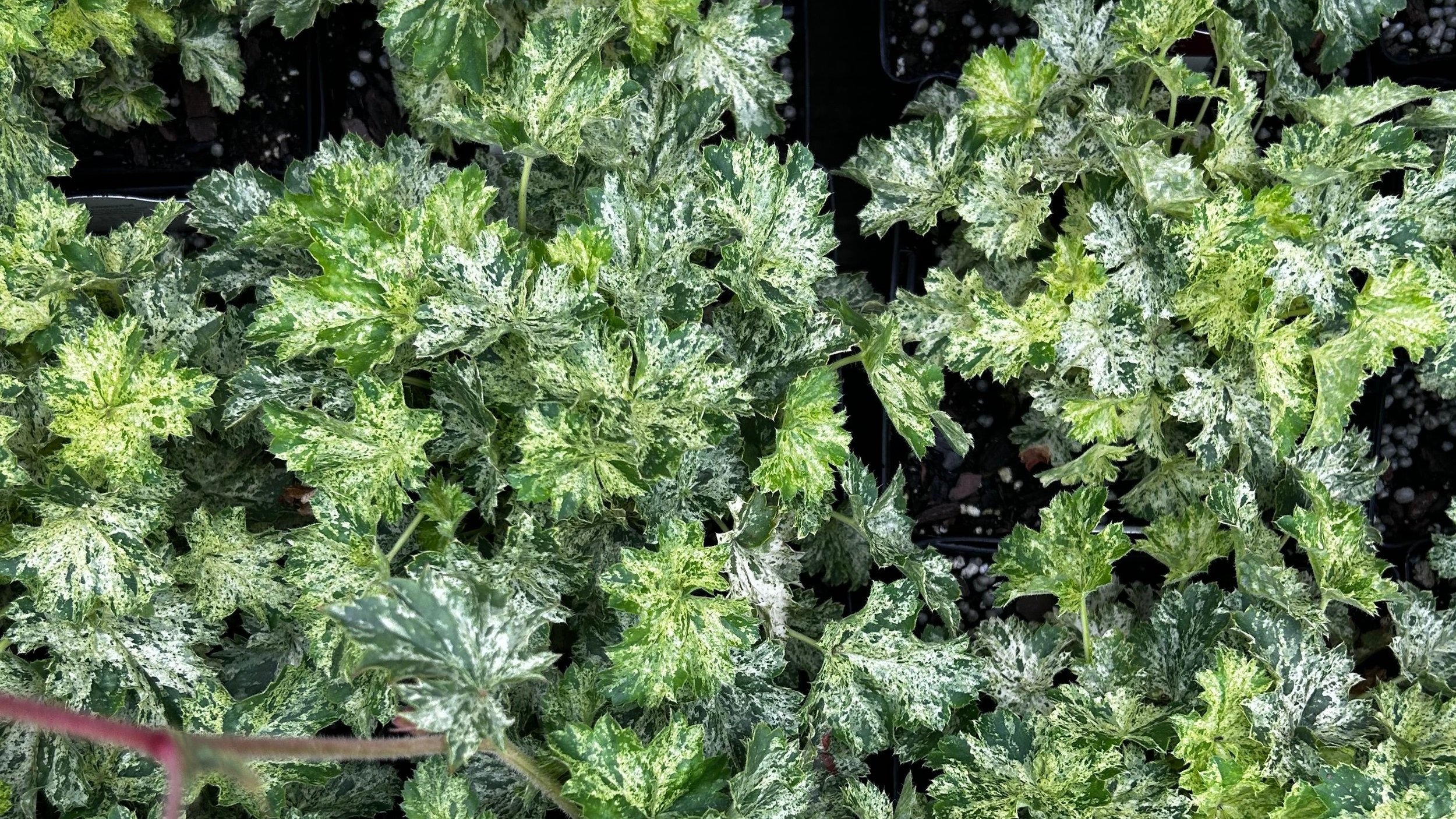
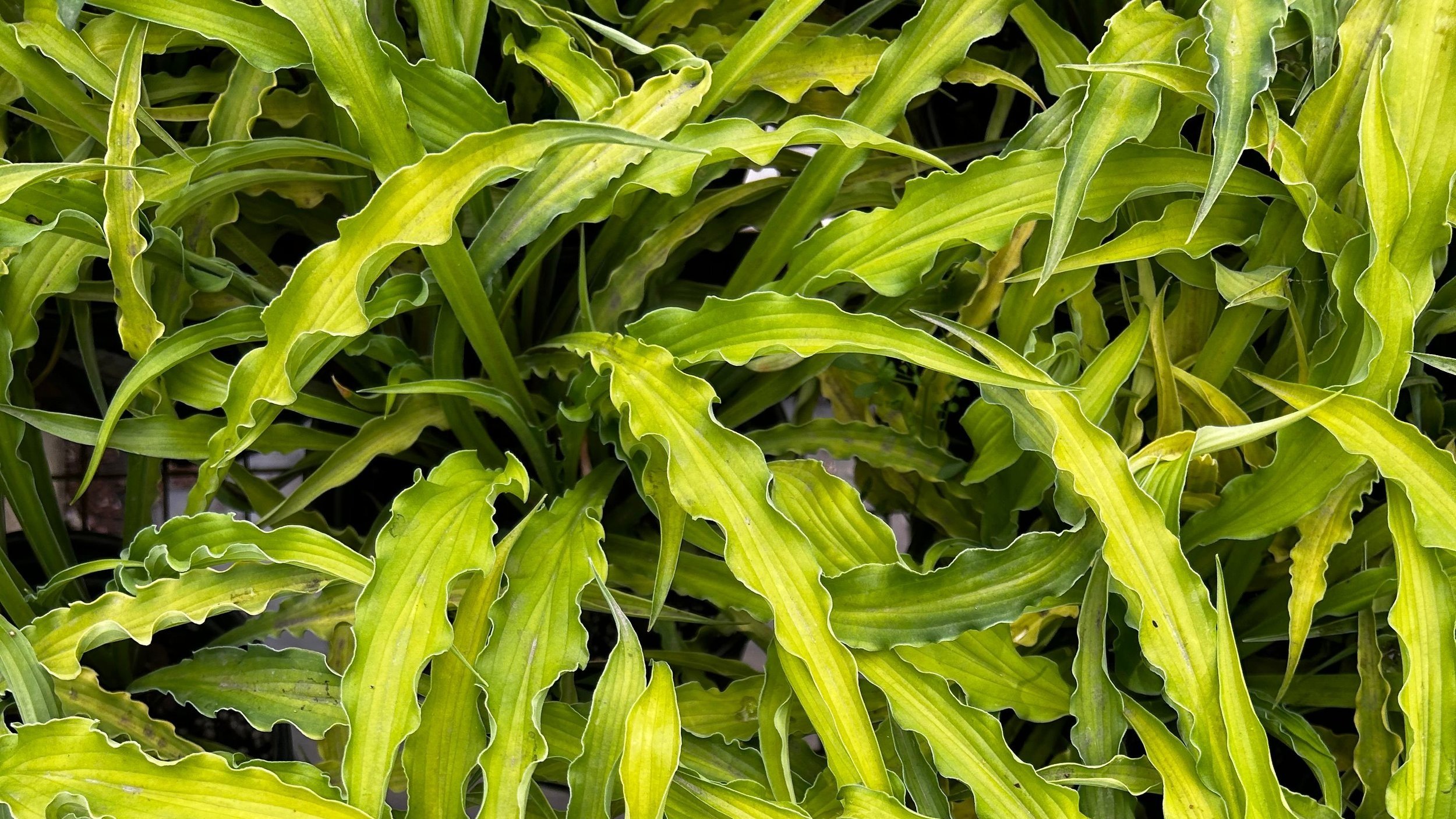
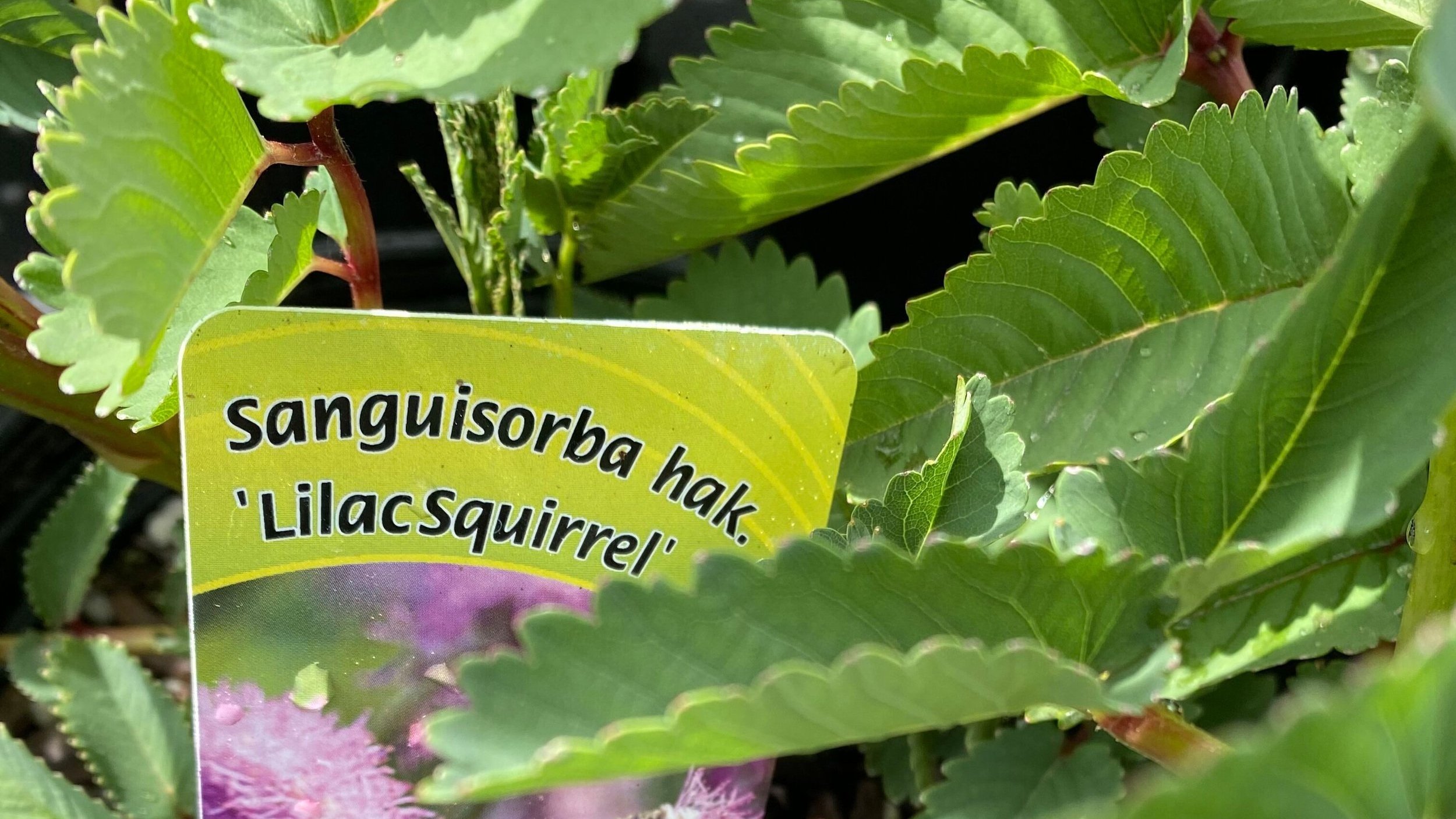

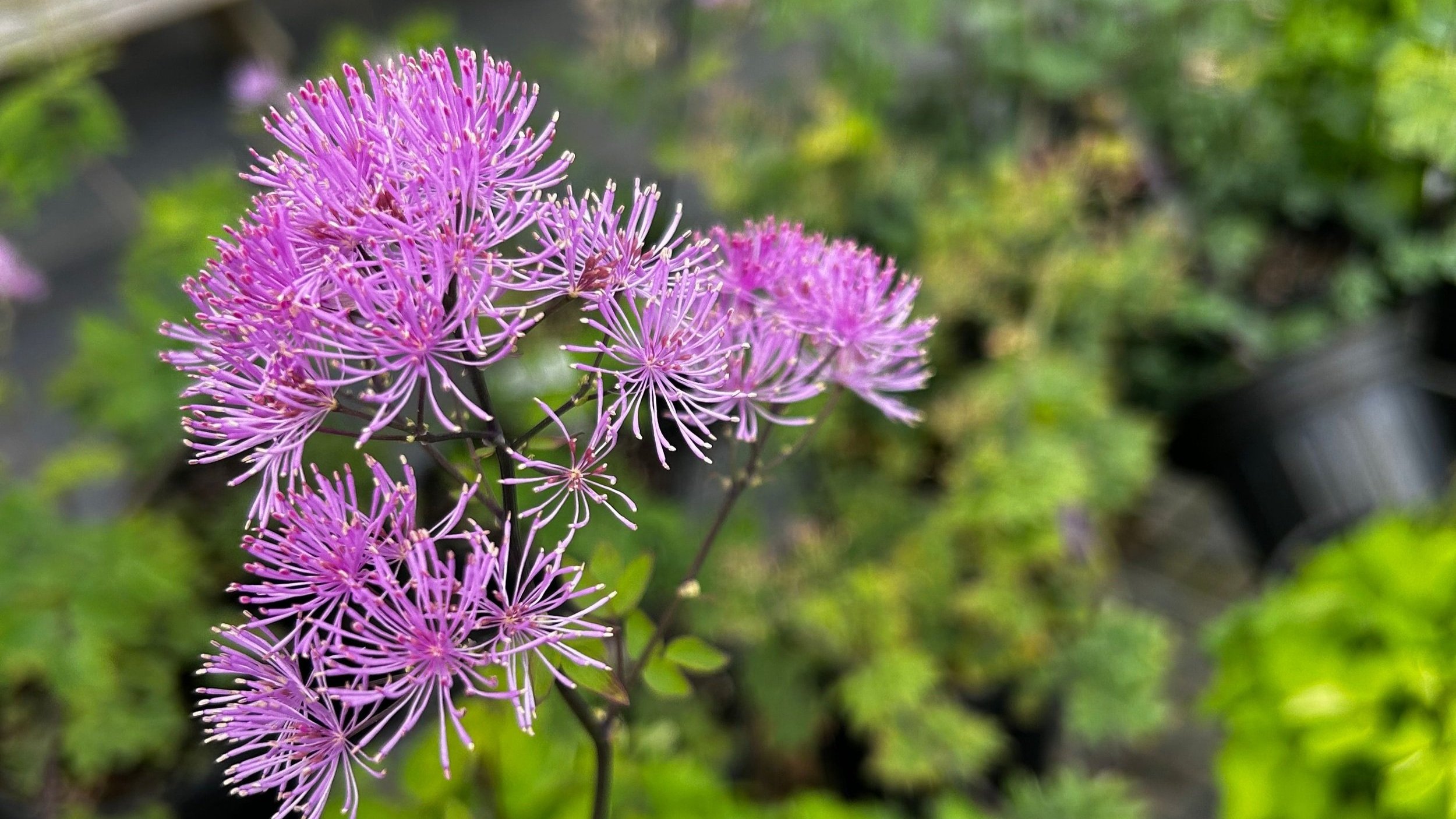
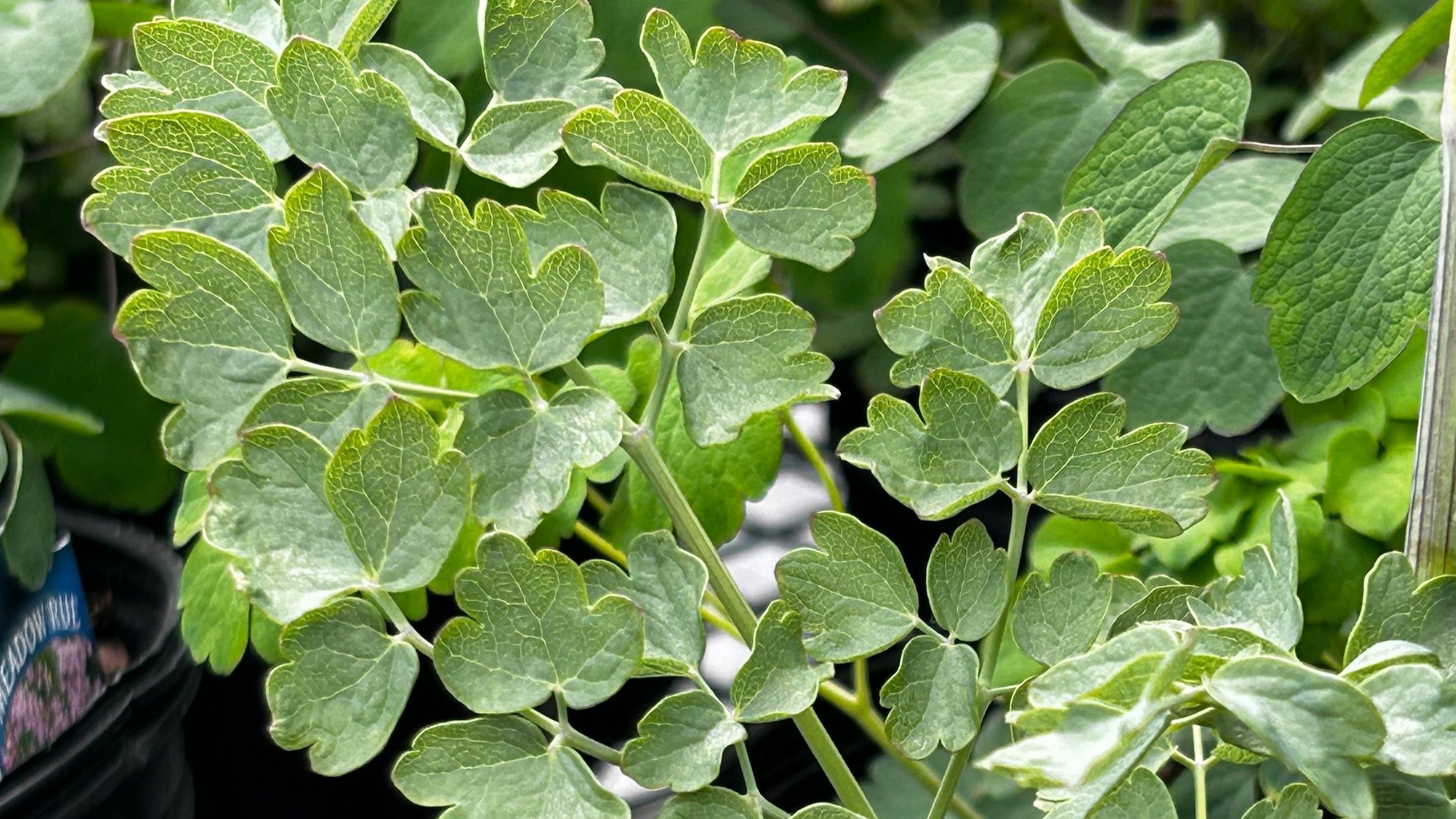
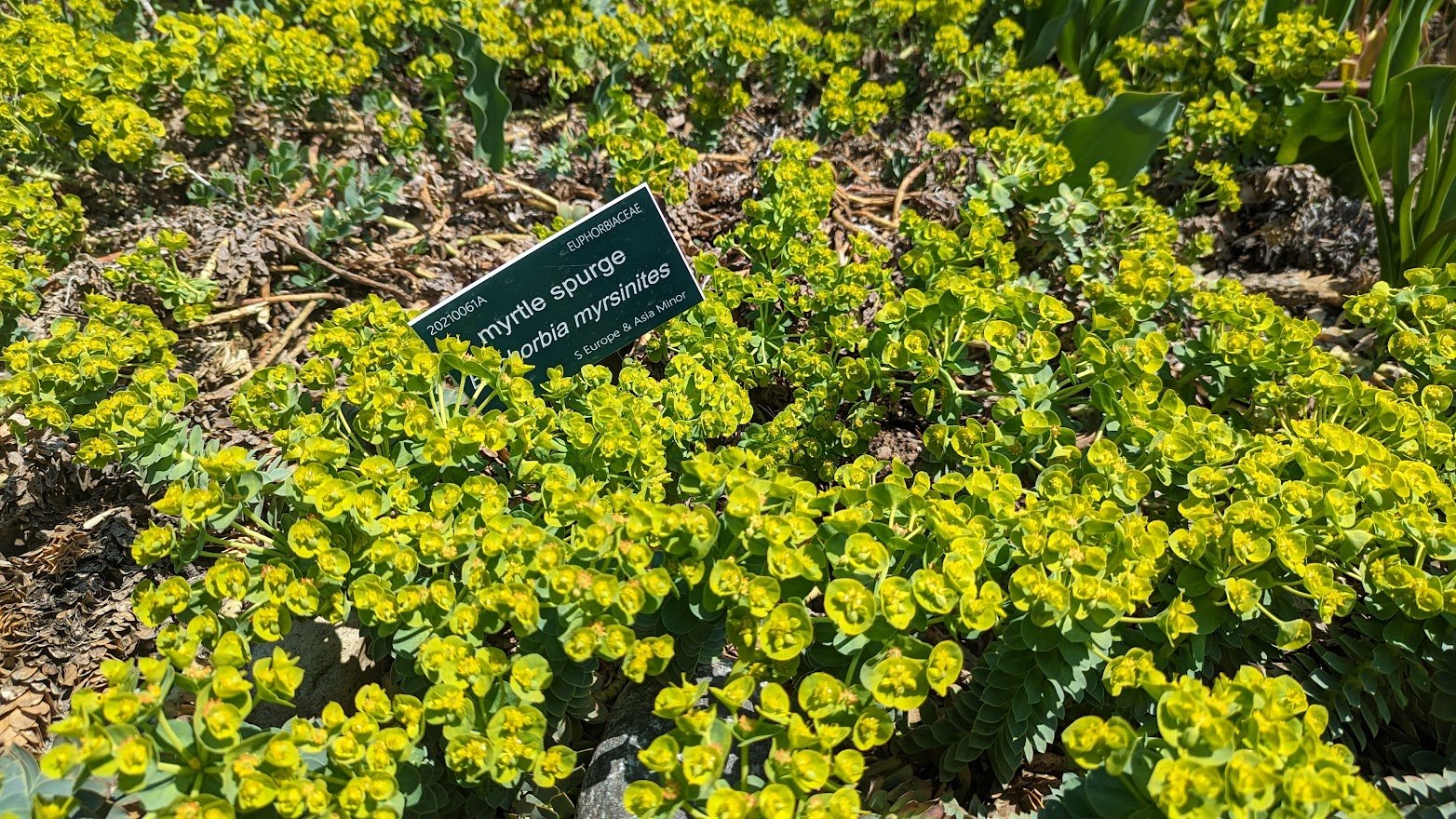
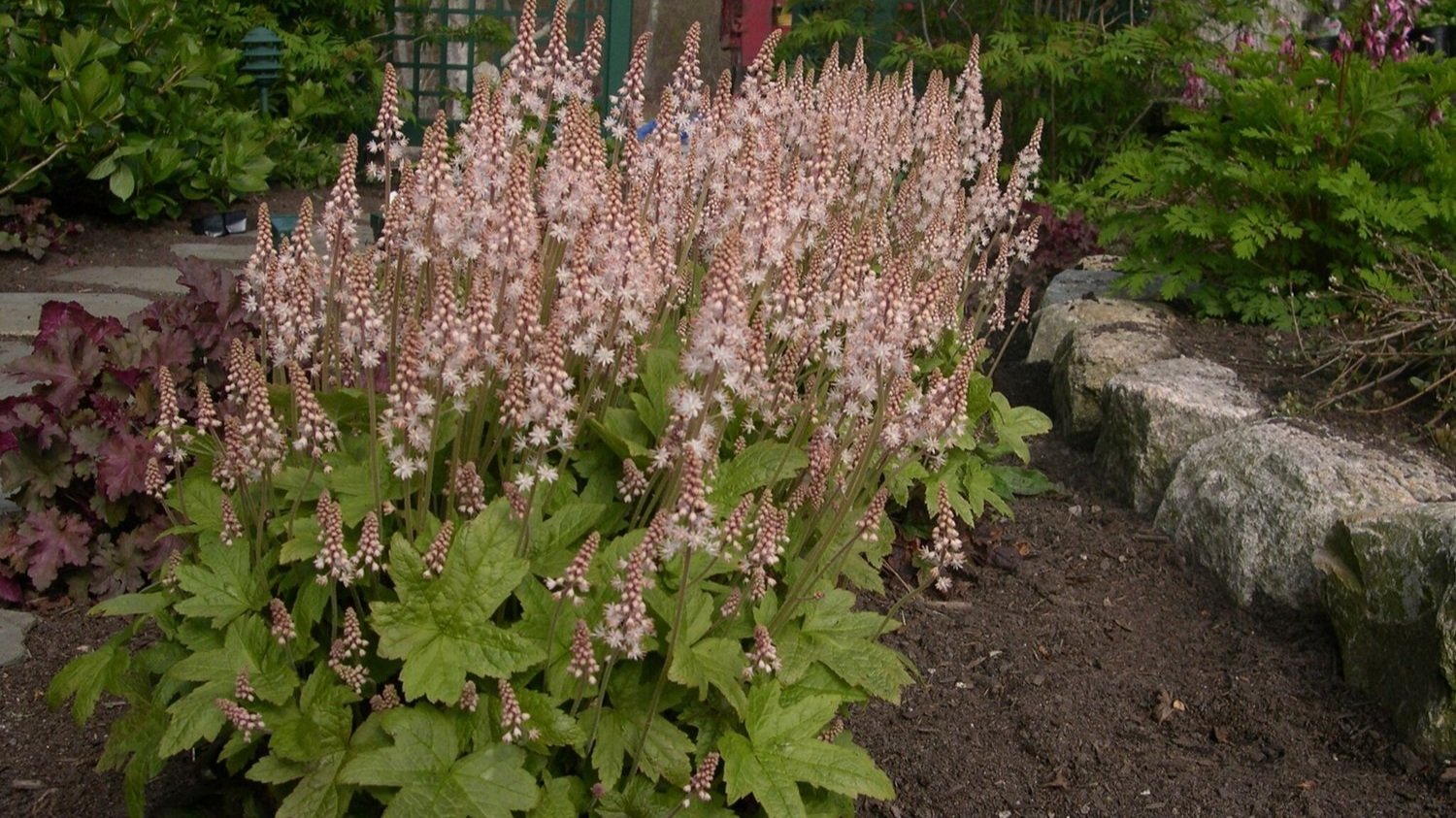
Ferns, Thalictrum, Rodgersia, Bleeding Hearts and Heucheras are all good choices for summer blooming shade if deer are a problem in your garden. Astilbes can add color to shade beds with their plumed flowers available in many colors and sizes. Many Heucheras also called Coral Bells, can add color with their foliage which comes in reds, bronzes, deep purples and green. The Heucheras will bloom for 3-4 weeks in summer and their foliage will last all summer. Everblooming Bleeding Hearts start blooming in early summer and continues blooming until late summer. Unlike it’s cousin, Dicentra spectabilis, only blooms in spring and goes dormant in summer. It will thrive in partial shade and spread and is also deer resistant.
Bleeding Hearts
Plant ground covers and fill up the spaces with plants instead of mulch! Perennial groundcovers thrive and spread in partial shade. Pachysandra is the most shade tolerant. Vinca minor, Asarum and Epimedium are all good choices as well.
Perennial Geraniums and Campanulas will bloom in partial shade. Geranium Rozanne is our best selling Geranium. Geranium sanguineum Album, with white flowers and Geranium cantabrigiense Karmina, with pink flowers and fabulous fall color, are also great plants. The peach leaved Campanula persicifolia comes in blue and in white, both tall and short. The Takion series is the more compact one. We also carry Campanula poscharskyana, Campanula portenschlagiana Blue magic and Campanula rotundifolia, all shorter wider plants that can handle more sun and thrive in walls and cracks in walks. This always indicates they don’t need rich soil. New this year is Campanula cocchlearifolia in both white and Blue. We grew these from seed which was seeded in June of 23
plant profile
national wildlife federation
Astilbe illustration by karen blackerby logan
******************************************
Astilbe are perennial flowers that bloom in spring and summer. They grow well in shady areas where other flowers won't thrive. They add swaths of color to shade beds with their plumed flowers available in many colors and sizes. Their soft feathery blooms come in shades of purple, lavender, red, white or pink. Their glossy fern like foliage comes in shades of green, bronze or deep brown. Astilbe are usually deer resistant but we are finding that at times deer are snacking on them as well.
We recommend planting Astilbe in combination with plants that have similar cultural requirements. Astilbes require plenty of water and some afternoon shade. Some combinations we recommend are shrubs like hydrangeas or Hypericum and perennials such as Rodgersias (Roger’s flower), Snakeroot, Cimicifuga, Thalictrum or ferns.

PLANTING TIPS
____________
* Plant in shade to
part shade
* Plant in a loamy
humus rich soil
* Water deeply
to promote
deep roots
* Protect from hot
afternoon sun
***************
Regularly check Astilbes to make sure they are moist.
Astilbes spread quickly and form broad clumps.
Apply organic fertilizer in the spring.
Divide the overgrown clumps every 3 to 4 years in the spring.
Typically you can remove spent flower blooms to encourage
more blossoms but Astilbe are the exception.
Astilbes spent flowers have ornamental value.
They can be left standing if desired or cut down at any time.
Astilbes continue to provide attractive foliage until fall.
***************
***************
Vineyard Gardens we carry 25-30 different cultivars.
Astilbe chinensis Pumila: Forms a ground cover. Height: 10” tall.
Astilbe Hennie Graafland: Dwarf Astilbe. Height: 12”-18” tall.
Astilbe Superba: One of the tallest pinks. Height: 24”-48” tall.
Astilbe Mighty Red Quin: Height 39”-47” tall
Astilbe Montgomery: Height 20-24” tall
Other Varieties we carry:
Astilbe Erika, Mighty Pip, Purple Candles, Bressignham, Beauty, Delft Lace, Little Visions in Pink, Straussenfetter, Dueschland, Visions & Mauve
***************
low maintenance groundcovers
As the heat ramps up there are many ways to keep your garden looking beautiful.
*******************************
Season Extenders: Plant late bloomers and season extenders in your garden now. They will grow in nicely and then extend the color in your garden late into the season. Try adding tender salvias like Salvia guaranitica Black and Blue, Pineapple sage, or the new Dalvia uliginosa with a baby blue flower color. Also plant asters and mums or the more unusual chrysanthemum pacificum.
Spent bulb foliage: Now is the time to cut back any yellowing daffodil foliage. It should be left intact as long as possible as the plant photosynthesizes and stores energy for the next season in the bulb underground.
Shaping perennials: The last pinch to shape and encourage branching on asters, chrysanthemums and some late summer perennials should occur in early July. It’s still ok to thin stems on congested perennials to improve air circulation. Don’t be afraid to give a hard cut to catmint (Nepeta), lady’s mantle (Alchemilla mollis) and perennial geraniums (Geranium sp.) after the spring flowering.
Container plants: Consider compost tea, organic liquid feed like fish emulsion or seaweed extract for container plants. Feed every 7-10 days. As the summer heats up, they may need to be watered every day if it is sunny. We recommend once per day deep watering and make them hold because it makes for a tougher plant. If plants are not wilting and look happy they do not need water. They will let you know if they need water by starting to wilt or lose their turgidity, then no question it’s time to water. It’s better to have tough plants than spoiled ones!
Weeds: Catch weeds before they go to seed and continue to add organic mulch to spots left bare or plant another plant, like a season extender. Shredded leaves held over from fall cleanup make a wonderful mulch for annual and perennial borders as well as vegetable gardens. It’s natural, free, local and breaks down over the course of the growing season to add organic material to the soil.
Peonies: Remove spent flowers from peonies once flowering is finished. If plants were staked or tied up to prevent flopping during bloom, the stakes and strings can now be removed which will make the stems stronger to stand on their own.
Vegetable garden: Direct sow succession crops in your vegetable garden for the next round of harvest, such as radish, lettuce, carrots, chard, and beets. Side dress heavy feeders and long season crops like corn, tomatoes, squash, peppers, potatoes, onions and eggplant with a balanced fertilizer now.
Biennials: Sow seeds of biennials like foxgloves, Angelica, Salvia sclarea, Lunaria and Dianthus now for planting in the garden in late summer. These will produce leaves this year, overwinter and flower next year, ending their life cycle when they set seed in their second season.
Irrigation: Irrigate borders and lawns infrequently and deeply. Generally, lawns and gardens need 1” of water each week, or a deep irrigation that penetrates to 6”. Keep track of rainfall using a rain gauge and supplement only as needed. Consider converting parts of your lawn to lower maintenance groundcovers, shrub or perennial borders, or meadow plantings.
Japanese beetles: Depending on your location, Japanese beetles begin to emerge from the soil around July 4th. Keep a close eye out for them, scouting in the morning when they are sluggish and knocking them into a pail of soapy water. The solitary fly, Istocheta aldrichi, is an internal parastite of adult Japanese beetle. Female flies lay eggs on the thorax of female beetles. Upon hatching, the maggot bores into the beetle, killing it. Japanese beetles observed with these eggs on them should be saved to encourage this natrual control method.
-Joann Vieira, Director of Horticulture, Trustees (UMass Extension Landscape, Nursery and Urban Forestry Program)
Echinacea ‘White Swan’

Lobelia Starship Scarlet
Rudbeckia fulgida Goldsturm
creating habitat
Garden Ideas

Virginia Bluebells [photo by keith kurman]
Low-growing, ground-hugging perennial plants are the best low-maintenance ground coverings. Groundcovers bring color, textural interest, plant food/shelter for insects and a great replacement for mulch. They can even be an alternative to lawns. Native groundcovers require no fertilizer and only supplemental watering. There are evergreen groundcovers that cover throughout the winter and help with erosion control. Some groundcovers thrive under canopy of shade others do well in full sun.
WOOD SPURGE (Euphorbia Robbiae): A deer-resistant evergreen groundcover that is spread stoloniferously. A vigorous spreader, blooming in spring on 18” tall stalks. They prefer a little afternoon shade.
PERSICARIA: A taller groundcover with late season flowers, spanning four months from July to October. A vigorous, stoloniferous spreader. We have available Alba, Amethyst Summer and Fat Domino.
SWEET WOODRUFF (Galium odoratum): Sweet Woodruff is a lovely plant that will spread like a groundcover in your garden. It has small white flowers in spring through early summer. It’s vigorous but not aggressive and can coexist nicely with bulbs that will come right up through it. They spread stoloniferously by sending out stolons or side shoots just beneath the soil surface. An ideal ground cover around shrubs and/or as a border accent in woodland gardens. It thrives in rich garden soil, in part to full shade.
HYPERICUMS CALCYNUM (St. John’s Wort): A ground cover with large yellow flowers. It can take partial shade but likes a little afternoon shade. With this groundcover more sun equals more flowers! Hypericums calcynum spreads stoloniferously (through underground stems). If it likes the spot, it will spread vigorously. A pollinator magnet!
PACHYSANDRA: We carry the Japanese spurge, pachysandra terminalis. Our favorite is the native one, Pachysandra procumbens. Pachysandra is considered an evergreen groundcover.
VINCA: We carry Vinca minor Bowles, with the early summer blooming blue flowers and the white flowering Vinca minor. We also carry Illumination, a vinca cultivar with yellow variegated foliage and a blue flower.
EPIMEDIUM, BARRENWORT: A less common groundcover that thrives in shade. This year we have Sunny and Share, Ellen Willmot, Pink Champagne, Red Beauty and Nanum.
FERNS: Ferns can spread nicely like ground covers such as Matteuca struthiopteris (the Ostrich fern), Dennstaedtia punctiloba (Hay Scented Fern) and Onoclea sensibilis. Dennstaedtia punctiloba and Onoclea sensibilis are both hard to find. We don’t have either in stock right now.
GEUM: The native Geum is a good ground cover. Geum triflorum has beautiful seed pods.
THYME: Creeping and wooly thymes are ground covers we like to recommend for sun. Creeping thyme comes in white flowers (albiflorus), red flowers (coccineus) or pink chintz with pink flowers. We also carry creeping lemon and Elfin thyme.
LAURENTIA fluviatilis ‘BLUE STAR CREEPER’ and PRATIA: Two other interesting plants that spread like ground covers.
Gingers bloom in early spring. The flowers are hidden beneath the foliage, rarely seen and are pollinated by ants! They are grown for their foliage which spreads and in certain species is evergreen, like the europeum.
EUROPEAN GINGER (Asarum europeum): a spreading perennial ground cover with shiny rounded leaves.
In my opinion there isn’t a prettier flower than a Blue Bell. They spread and form large clumps with beautiful blue flowers in spring. They don’t bloom all summer so it’s a good idea to plant in combination with a later emerging and blooming perennial. The later blooming perennial will fill in the space nicely when the Virginia Blue Bells are past their bloom and dormant until the following spring.
MERTENSIA virginica ‘VIRGINIA BLUEBELLS’: They do best with a little afternoon shade.
Virginia Bluebells
*****************
Succession Gardening is a new concept in groundcovers where one plant replaces another one that is gone by in the same area. These ‘groundcovers’ may not spread stoloniferously but they will cover the ground where another plant has passed.
Alchemilla, Perennial Geraniums, Hostas, Euphorbia, Lupine, Rodgersia, Cimicifuga, Aruncus, ornamental rhubarb (Rheum), Bronze Fennel, (Foeniculum vulgare), Sanguisorba , Aconitum, Foxgloves and Thalictrum, can all be used as plants that emerge late and will cover up earlier blooming plants. They will grow up, over and fill in the space when early bloomers and cool weather annuals finish blooming and go dormant, like Virginia Bluebells (Mertensia virginica)or Bleeding heart (Dicentra spectabilis).
Enjoy the bulbs in spring and then cover up their foliage with Ladies Mantle(Alchemilla mollis) or Geranium sanguineum album.
Hostas are late to emerge and are also often planted in areas where you have early bloomers that don’t last all summer, like Trilliums, Shooting Stars(Dodecatheons) or bulbs like Crocus or Chionodoxa.
It may take larger plants such as Thalictrum to cover up larger bulb foliage like daffodils or Fall crocus (Colchicum). Even Cammasia foliage can be hidden away after it’s done blooming! The Thalictrum will come right through the messy bulb foliage and cover it right up. You don’t even have to cut it back.
for beauty & biodiversity
share your habitat

Hypericum illustration by karen blackerby logan
************************************
Hypericum is a compact, mounded, deciduous shrub. During midsummer this outstanding pollinator shrub is adorned with vibrant yellow blooms with abundant pollen bearing stamens, backed by gray blue fine textured foliage. Hypericum is a perfect speciman for any sunny or part shady garden. During the winter the attractive cone shaped seed pods remain, offering food for birds and late season visual interest. St John’s Wort prefers moist well drained soil but can adapt to most soil types, drought, soil compaction and salt. They grow naturally on rocky ledges, in sandy areas and woodland openings. They bloom on the new growth.
Hypericum mass planted as a hedge
Hypericum integrated into a perennial garden
**************
Hypericum hidcote: A very popular variety with blue foliage and a long blooming period. Larger yellow flowers than the Floral Berry but not as impressive of a berry display.
Floral Berry: Multi season interest. The yellow flowers are followed by amazing berries in the fall
Hypericum calycinum: A ground cover with large yellow flowers. It can take partial shade but likes a little afternoon shade. With this groundcover more sun equals more flowers! Hypericums calcynum spreads stoloniferously (through underground stems). If it likes the spot, it will spread vigorously. A pollinator magnet!
Hypericum Blue Festival and Sunny Boulevard
**************
**************
Mass plantings along borders, hedges and good for stabilizing slopes
**************